- Search Please fill out this field.
- Manage Your Subscription
- Give a Gift Subscription
- Newsletters
- Sweepstakes
- National Parks

How to Plan the Perfect Trip to Everglades National Park
Here's everything you need to know before planning a trip to Everglades National Park.
Evie Carrick is a writer and editor who’s lived in five countries and visited well over 50. She now splits her time between Colorado and Paris, ensuring she doesn't have to live without skiing or L'As du Fallafel.
:max_bytes(150000):strip_icc():format(webp)/evie-carrick-df91be43396540c492c4141c56a71a9e.jpg)
- Planning Your Visit
How to Get There
- Best Time to Visit
Best Things to Do in Everglades National Park
Must-see wildlife and natural features, where to stay, where to eat.
Visit Florida
Those who associate wide-open wilderness areas with the Western United States likely haven’t been to Everglades National Park. The Florida park stretches across 1.5 million acres and protects the largest designated wilderness area east of the Rocky Mountains. In the Everglades, alligators and crocodiles coexist (and are seen regularly), and the flora and fauna are so robust that this national park was the first set aside purely for its biodiversity.
“Everglades is not only a national park, but also a World Heritage Site, an International Biosphere Reserve, a Wetland of International Importance, and a specially protected area under the Cartagena Treaty,” explained Allyson Gantt, chief of communications and public affairs for Everglades National Park and Dry Tortugas National Park, in an interview with Travel + Leisure . "I love sharing the complexities and beauty of this park with visitors.”
Meet the Expert
Allyson Gantt has been a National Park Service ranger for over 25 years, currently serving as the chief of communications and public affairs for Everglades National Park and Dry Tortugas National Park.
Gantt knows first-hand what makes Everglades National Park a special place — along with the ins and outs of what first-timers should know and what not to miss.
Stephanie Pollak/Travel + Leisure
Planning Your Visit
Everglades National Park is massive, so Gantt says it is vital to show up with a plan for what you will do and see. “Because of the geographic spread of the park, visitors may want to focus on one area if they only have a few hours or one day.”
The park is open year-round but offers two very different experiences based on when you visit. The dry season (December to April) is busier, with better weather, more wildlife, and fewer mosquitos, while the wet season (May to November) is quieter. Visitors can buy a park pass in person at the Homestead or Shark Valley entrances to the park or at the Gulf Coast Visitor Center at the Everglades City entrance. If you’re visiting during the busy dry season, especially on a weekend, buy your park pass online through Recreation.gov to avoid waiting in long lines at the entrance gate. A pass for a single vehicle or vessel is $35 and is valid for seven days.
Even if you do buy a park pass in advance, the Homestead and Shark Valley entrances are notoriously congested with limited parking during the busy winter season. The park website says , “It is recommended to visit these areas on weekdays, arrive early in the day (before 10 a.m.), and carpool to the park if possible.”
Due to its size, Everglades National Park has three entrances in three different cities. A car is a must because the park has no public transportation and the three entrances are at least an hour from each other.
The southern section of the park is best accessed from the Homestead entrance, which is the park’s primary entrance. The Homestead entrance is outside Homestead, Florida and has the Ernest F. Coe Visitor Center and the Guy Bradley Visitor Center (at Flamingo). Homestead also provides access to the neighboring Royal Palm State Park .
The northern section of the park is best accessed from the Miami or Everglades City entrances. The closest entrance to Miami is Shark Valley, which has the Shark Valley Visitor Center. The entrance closest to Naples is the Everglades City entrance, which has the Gulf Coast Visitor Center.
lucky-photographer/Getty Images
Best Time to Visit
As we mentioned, there are two very distinct seasons in Everglades National Park: dry season and wet season. If you come between December and April, you’ll experience the dry season, which comes with cooler temperatures and fewer mosquitos. The dry season’s preferable climate aligns with the park’s busy season — and it's also when most of the wading birds (and their predators) can be seen.
The wet season in the Everglades typically runs from May to November, and it's rainy with lots of mosquitoes. The weather and bugs that come along with South Florida summers lead to fewer visitors — which can be a major plus.
“The wetter summer season offers incredible cloud formations and calmer waters for boating and fishing,” Gantt adds. “The shoulder seasons, especially November/early December and late April into May, can be less busy times to visit, but still have plenty of opportunities to enjoy all the park has to offer.”
It’s impossible to feel bored during a visit to Everglades National Park. The expansive park has more than its fair share of interesting ecosystems and wildlife. There are marine and estuary topographies, cypresses and mangroves. There’s a lot to see and do, but for a first-time visitor, Gantt has a few specific recommendations.
Drive the Homestead Entrance Road and hike.
“The Homestead entrance has a 38-mile road with multiple stops with short trails through a variety of the park habitats,” said Gantt, who notes that this is a good way to get acquainted with the southern section of the park.
She specifically recommended the Anhinga Trail , a short route that is wheelchair accessible and starts from the Royal Palm Visitor Center. Alligators, turtles, herons, and egrets are often seen along this trail.
Join a tram tour for wildlife sightings.
Near the Shark Valley entrance is a paved 15-mile loop that goes along the Shark River Slough, where alligators, turtles, and many bird species are often found. The trail is great for walking, but if you want to do the full 15 miles, your best bet is to rent a bike or hop on the tram — both of which are available through Shark Valley Tram Tours . There’s also an observation tower in the Shark Valley area with a viewing deck that overlooks alligators, turtles, fish, and birds.
Gantt notes that at this part of the park, “Visitation is higher and parking can be challenging on busy weekends and holidays.”
Take an airboat tour.
There are three airboat companies that operate in the park, and Gantt says cruising through the Everglades on a flat-bottomed boat is a must during your visit. The three operators with permission to operate in the park are Coopertown, Everglades Safari Park, and Gator Park.
Visit the mangroves and Florida Bay.
From the Homestead entrance you can get to the Flamingo area, which is considered the gateway to Florida Bay. The bay and the mangrove-lined waterways that feed into it are home to much of the park’s marine life.
“At Flamingo, we offer narrated boat tours through the mangroves and also on the open water of Florida Bay. There are several great trails in the area for paddling as well as the open area of Florida Bay. Manatees, crocodiles, and osprey are frequently seen around the marina,” said Gantt.
Beyond the marina, which has a small store and a gas station, the Flamingo area of the park has a campground and kayak, canoe, and bicycle rentals (through Flamingo Adventures ).
Cruise through the Ten Thousand Islands along the Gulf.
If you want to play along the watery landscape of the Gulf Coast, head to the Everglades City entrance near Naples. This area is the gateway for expeditions to the Ten Thousand Islands, a maze of mangrove islands that are only accessible by boat. The Gulf Coast Visitor Center was destroyed by a hurricane in 2017 and is being rebuilt, but you can still book a boat tour to the Ten Thousand Islands with Everglades National Park Adventures . The two-hour tour takes place on a 49-passenger pontoon boat with a trained guide and occasionally an Everglades park ranger.
Troy Harrison/Getty Images
The Everglades is essentially a giant wetland that consists of sawgrass marshes, pine flatwoods, and coastal mangroves. The boggy wilderness is both beautiful and daunting, especially when you consider that it’s home to a huge number of animals, including the Florida panther, the West Indian manatee, and the endangered leatherback turtle.
But no creatures are as synonymous with the Everglades as the alligators and crocodiles. Gantt notes that “South Florida is the only place in the world where [alligators and crocodiles] coexist thanks to the combination of freshwater and saltwater areas.”
Beyond frequent sightings of the large reptiles, Gantt says the park has a huge number of birds, and it's “on the migratory path for a number of species, thus offering fantastic birding opportunities, especially in the winter.”
Animals aside, Everglades National Park has a large number of plants, trees, and landscapes, from coastal mangroves to hardwood forests. Remember, the park was originally protected because of its biodiversity, which is its biggest draw.
Flamingo Lodge
There is only one hotel within Everglades National Park, and it just opened in late 2023. The Flamingo Lodge is located at the southernmost tip of the Florida peninsula and can be reached via the Homestead entrance. The lodge has 24 rooms including eight two-bedroom suites that can accommodate up to six people. The highlight of each room is the east-facing balcony that provides sunrise and sunset views over Florida Bay.
Flamingo Glamping Tents and Houseboats
Beyond the new Flamingo Lodge, the Flamingo area of the park has two “glamping” options — one on land and one on water. Visitors can rent one of the safari-style glamping tents , which have a fan and electricity. You will need to bring your own sleeping pad and bag.
For a unique lodging option, book one of the 42-foot houseboats , which have kitchens, bathrooms, linens, and air conditioning. The houseboats can sleep up to six people and can be taken out on the water.
Related: Best Places to Go Glamping in Florida
Long Pine Key and Flamingo Campgrounds
The only other in-park lodging options are the Long Pine Key and Flamingo campgrounds . Both campgrounds have RV and tent sites and can be driven to. The Long Pine Key Campground is the most accessible and is located near the Homestead entrance, while the Flamingo Campground is set deeper inside the park in the Flamingo area. Both campgrounds offer great stargazing and easy access to the Flamingo Marina, a popular launch site for fishing trips.
Boogich/Getty Images
The new Flamingo Restaurant is adjacent to the Flamingo Lodge and is the only full-service restaurant in the park.
“The new Flamingo Restaurant offers breakfast, lunch, and dinner, plus a full-service bar,” said Gantt. “Anglers heading out on the water with a licensed fishing guide can also try the restaurant's Cook Your Catch offering, bringing back their fresh fish to be prepared by the restaurant.”
There are plenty of dining options in cities surrounding the park — Miami, Naples, and Homestead — but most visitors bring their own food and drinks into the park. There are picnic tables at Long Pine Key and Flamingo campgrounds.
For grab-and-go snacks and drinks, Gantt says you can find a limited selection at the park’s visitor centers (Ernest F. Coe Visitor Center, Royal Palm Visitor Center, and Shark Valley Visitor Center) and at the Flamingo marina shop.
Related Articles
Everglades National Park: The Complete Guide
:max_bytes(150000):strip_icc():format(webp)/ElizabethHeath-Headshot-horiz-e7525e97616245958bf3d94e8db7f119.png)
- Things to Do
- Best Hikes & Trails
- Other Activities
Camping and Hotels
How to get there, accessibility, tips for your visit, everglades national park.
Everglades National Park , the third-largest national park in the U.S., is a vast, diverse and fascinating wilderness area that takes up most of the bottom tip of the Florida peninsula. The 1.5 million acres of wetlands are filled with millions of alligators, turtles, wading birds, fish, and many endangered species, including the extremely rare Florida Panther. Wilderness areas include pine uplands, sawgrass rivers, hardwood forests, mangrove islands, and boggy marshlands. Everglades National Park is only accessible from three different points, each quite some distance from one another. No roads run through the center of the park or connect one visitor center to another.
Visitors to Everglades National Park are virtually guaranteed abundant animal sightings, especially of wading birds and alligators, and the chance to experience and learn about the fragile ecosystem of the U.S.'s largest subtropical wilderness area. Whether you do a deep dive into the park or just visit for a few hours, the "untamed" nature of the Everglades is immediately obvious—this is definitely a place where wildlife and an often inhospitable environment are to be respected and given deference.
Things to Do in Everglades National Park
There are four park visitor centers accessed from the three park entrances. Activities and animal-sighting probabilities at each of these visitor centers vary according to the terrain.
Gulf Coast Visitor Center
The park's Gulf Coast Visitor Center is located in Everglades City, which, along with neighboring Chokoloskee, is the southernmost city on Florida's west coast. After a 2017 hurricane destroyed the permanent visitor center, a temporary center has stood in its place. The Gulf Coast Visitor Center is the access point to the Ten Thousand Islands, a network of mangrove islands that starts at Marco Island and stretches down the rest of the west coast. There are bathroom facilities but no food or drink services at the visitor center, though these can be found in Everglades City. Boat rides from the center allow visitors the opportunity to spot a host of wading birds, including rare white pelicans, as well as bottlenose dolphins and, with any luck, endangered West Indian manatees. You're not likely to see alligators here, as they prefer brackish water and areas of dry land to sun themselves on.
Activities and services available at the Gulf Coast Visitor Center include:
- Interpretive displays
- Maps and brochures
- Backcountry permits
- Ranger talks
- Interpretive tours of the Ten Thousand Islands on a pontoon boat
- Canoe and kayak rentals
- Birdwatching from the shoreline
Need to know: Boat rides and rentals are offered through Everglades Florida Adventures , a park concessionaire. Camping in the Ten Thousand Islands is possible only with a backcountry permit, and primitive campsites with no water or facilities are only accessible by boat. Novice campers or boaters should not attempt wilderness camping or navigating the islands and the maze of waterways by boat. Many primitive campsites close from May to September, which is the bird-nesting season.
Shark Valley Visitor Center
Located on US 41, also called the Tamiami Trail, the Shark Valley Visitor Center sits on the northern edge of the "River of Grass," the vast area of freshwater prairie and slough that is actually a slow-moving river. The visitor center is located about 73 miles from Naples, on the west coast, and 40 miles from Miami , making it a reasonable day trip from either location. This is one of the park's most popular access points and offers nearly immediate animal sightings, including alligators sunning themselves right at the entrance drive. The visitor center has bathrooms, drinks, and snacks.
From the visitor center, a 15-mile paved loop road dips into the River of Grass and offers an easy introduction into the park's ecosystem. Visitors can walk, bike, or take a tram along the trail and readily spot alligators, American crocodiles, aquatic turtles, fish, including monster-sized alligator gar, birdlife, tortoises, and sometimes even otters or white-tailed deer. An observation tower at the trail's midway point offers sweeping views of miles and miles of wetlands.
Activities and services available at the Shark Valley Visitor Center include:
- Interpretive tram rides along the loop road
- Bicycle rentals
- Paved and unpaved walking trails
Need to know: Bike rentals, tram rides, and snack and drink services are offered through Shark Valley Tram Tours , a park concessionaire. December to March, Florida's dry season, are the busiest tourist months in Florida, and also peak viewing time for animals at Shark Valley, who gather in and around canals and watering holes. If you visit during this period, try to come mid-week, when the park is less crowded.
Ernest F. Coe Visitor Center
The largest and most comprehensive visitor center in Everglades National Park, the Ernest F. Coe Visitor Center is located on State Road 9336, 50 miles south of Miami on Florida's east coast. It's also the park headquarters. Located in the "swampier" section of the park, the visitor center is surrounded by dense forests and wet prairie and is another prime spot for wildlife watching. Services on-site include bathrooms and a nice gift shop that also sells snacks, drinks, and, crucially, mosquito repellant.
From the visitor center, guests will find walking trails with interpretive signage, wildlife-viewing platforms, and nearby, the Royal Palm Nature Center, with more informative displays, trails, and up-close animal viewing. Here, animal sighting possibilities include alligators (again!), roseate spoonbills, anhingas, and the usual vast range of wading birds and aquatic life. Though it's highly, highly unlikely you'll see one, Florida Panthers have been spotted around the visitor center.
Activities and services available at the Ernest F. Coe Visitor Center include:
- Interpretive displays and films
- Wildlife viewing platforms and boardwalks
- Park headquarters
Need to know: Where there's standing water, there are mosquitos, and this side of the park, especially, is dense with them. Bring your own bug spray, or prepare to run from your car to the visitor center to buy mosquito repellant—they're that prevalent here.
Flamingo Visitor Center
Quite literally the end of the road, the Flamingo Visitor Center sits at the end of State Road 9336, where it runs smack into the Gulf of Mexico at Florida Bay. It's 38 miles from the Ernest F. Coe Visitor Center, a drive made longer because there are so many good places to pull over to the side of the road and observe wildlife. Once you reach the water's edge, it may be possible to spot manatees, dolphins, and wild flamingos.
More developed than you might expect given its remote location, the Flamingo Visitor Center has a snack bar, a marina store, bathrooms, boat tours and rentals, a campground, and a gas station, in addition to interpretive displays and park info.
Activities and services available at the Flamingo Visitor Center include:
- Narrated boat tours
- Bicycle, canoe, kayak, and fishing gear rentals
- A developed campground
- Backcountry camping permits
Need to know: Boat tours and rentals, bike rentals and other paid services are offered through Flamingo Adventures , a park concessionaire. Bring or buy mosquito spray. If you're visiting for the day, either from Miami or Homestead/Florida City, time your visit so that you're not driving on the park road after dark.
Best Hikes & Trails
Because so much of Everglades National Park is underwater and so much of the backcountry is inaccessible, there are only a handful of hiking trails at the visitor centers, and they are short walks with no elevation change. There are no hiking trails from the Gulf Coast Visitor Center. Top trails include:
From Ernest F. Coe Visitor Center:
- Anhinga Trail: Accessed from the Royal Palm Nature Center, this .8-mile trail passes through a marsh and offers close-up views of wading birds and alligators.
- Gumbo Limbo Trail: This .4-mile trail passes in the shade of palm and gumbo limbo hammock and is a prime viewing area for lovers of orchids and bromeliads.
From Flamingo Visitor Center:
- West Lake Trail: This half-mile boardwalk is suspended over a mangrove swamp and stretches out into Florida Bay.
- Snake Bight Trail: An unpaved, 1.6 mile trail and section of boardwalk is prime terrain for spotting gopher tortoises, white-tail deer, and raptors.
From Shark Valley Visitor Center:
- Park Loop Trail: The 15-mile paved loop that's the centerpiece of Shark Valley has abundant wildlife viewing of a dizzying array of species and can be walked or biked.
- Bobcat Boardwalk: This half-mile raised boardwalk crosses over a sawgrass slough and hardwood hammock and permits a close-up view of the park ecosystem.
Other Activities in the Park
- Fishing is possible at the Gulf Coast, Flamingo, and Ernest F. Coe visitor centers. Fishing licenses are required for Florida residents and non-residents, and short-term licenses are available.
- Canoe, kayak, and motorboat rentals are at the Gulf Coast and Flamingo visitor centers.
- Biking and bike rentals are offered at the Shark Valley, Flamingo, and Ernest F. Coe centers.
There are developed campgrounds, some with electrical hook-ups, at the Flamingo and Ernest F. Coe visitor centers. Near the park visitor centers, the closest recommended hotels and motels are:
- The Everglades Rod & Gun Club , with rustic cottages and a historic bar and restaurant, is in Everglades City, one mile from the Gulf Coast Visitor Center.
- Those who wish to stay close to Shark Valley should consider Comfort Suites Miami-Kendall , 26 miles away, or the Miccosukee Resort & Gaming , a tribal-owned hotel and casino 18 miles away.
- Near Ernest F. Coe Visitor Center, there are several budget to mid-range hotels in Florida City, 9 miles away. Florida City is also the last mainland stop before the Florida Keys , making a convenient, if not particularly scenic, base for exploring the park and the Keys.
- At Flamingo Visitor Center, Flamingo Adventures rents houseboats and eco-tents and is developing a 24-room hotel with a restaurant scheduled to open in late 2021.
How you access Everglades National Park depends on what coast of Florida you're on and which visitor center you plan to visit. The Gulf Coast Visitor Center is convenient to Fort Myers , Naples, and Marco Island on the west coast, and there is an international airport in Fort Myers. The Ernest F. Coe and Flamingo visitor centers are closest to Miami and Miami International Airport . The Shark Valley Visitor Center is on US 41, one of the two roads that cut across the state's southern end. It's closer to Miami but accessible as a day trip from Naples. A car is needed to reach all the park access points.
Park visitor centers and bathrooms are wheelchair accessible. Many of the most popular park trails are paved for wheelchair access. Non-paved trails may be rutty but have virtually no elevation change. Guided boat tours are wheelchair accessible.
- Whenever and wherever you access the park, bring sunscreen, a hat, water, and mosquito repellant, as well as a camera and binoculars.
- Alligators may look lethargic as they sun themselves on dry land, but this should never be a temptation to get too close. Don't ever attempt to pick up or even get too close to baby alligators. Sure they're cute, but Mom is never far away.
- Don't ever attempt to feed or touch wildlife, even raccoons and birds that are used to mooching snacks from humans.
- Leashed pets are allowed on paved vehicular roads (but not the Shark Valley Loop) and campgrounds. They are not permitted on hiking and biking trails or in any wilderness areas.
The 13 Best Day Trips From Miami
Glacier National Park: The Complete Guide
Top 10 Activities in Everglades National Park
Skidaway Island State Park: The Complete Guide
Biscayne National Park: The Complete Guide
The Best US National Park for Every Outdoor Activity
Congaree National Park: The Complete Guide
Paradise Coast, Florida
Acadia National Park: The Complete Guide
Golden Gate Canyon State Park: The Complete Guide
Cuyahoga Valley National Park: The Complete Guide
First Landing State Park: The Complete Guide
Mount Diablo State Park: The Complete Guide
The 10 Best Long-Distance Cycling Trails in the United States
Yellowstone National Park: The Complete Guide
Bill Baggs Cape Florida State Park: The Complete Guide
- Skip to right header navigation
- Skip to main content
- Skip to secondary navigation
- Skip to primary sidebar

Learn how to easily plan your dream trip to Florida!
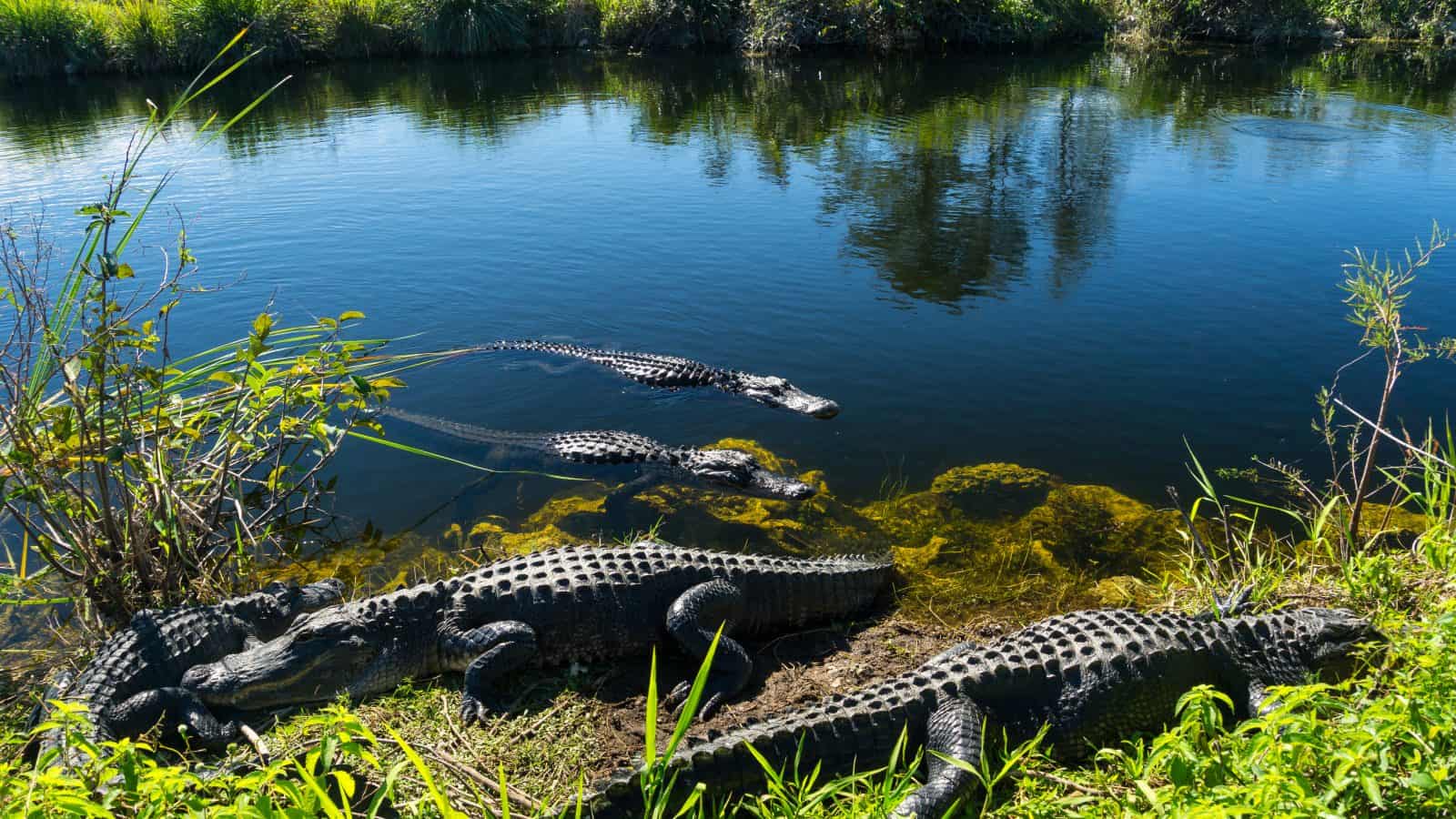
11 Best Things To Do In Everglades National Park
October 20, 2020 // by Florida Trippers
Florida has some of the best national parks in the country, but do you know about all the cool things to do in the Everglades? If you’ve never braved the swamps, mangrove forests, and trails of the Everglades, you’re in luck.
With over two million acres to explore, the Everglades provide endless recreation in Florida’s most beautiful ecological feature. So grab your bug spray, we’re here to help you take on one of the best national parks in Florida !
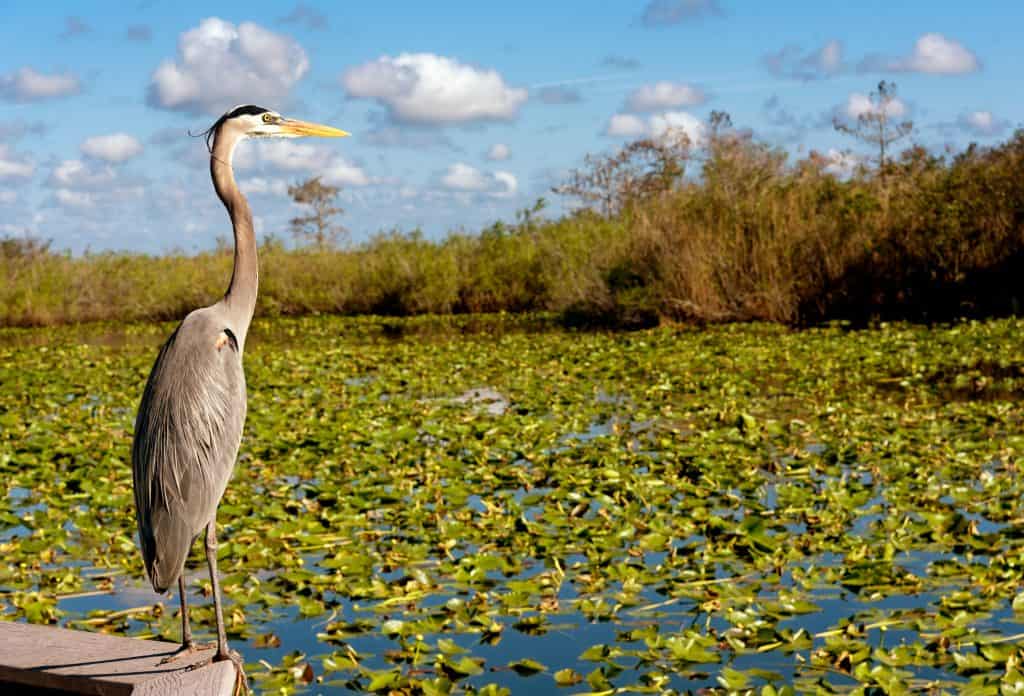
What Are The Everglades?
A subtropical ecosystem that spans over two million acres, the Everglades are an expansive set of wetlands and sawgrass marshes. During the wet season, Lake Okeechobee overflows, which releases water into a shallow river known as the “river of grass.”
As the water passes southward, it passes through several habitats. The slow trickle of water moves through cypress swamps, wet praries, and mangroves down to the Florida Bay.
Experiencing a wide range of weather patterns, the Everglades sees frequent flooding in the wet season as well as drought in the dry season. As the largest remaining subtropical wilderness in the country, the area is unmatched in its beauty.
Human life dates back to 15,000 years ago when Native American tribes inhabited the swampland. Its main inhabitants were the Seminoles as well as fugitive slaves. After the First Seminole War, exploration began in the area, as well as construction and maintaining passable trails.
Home to hundreds of animal species, you can find many of Florida’s native animals in the Everglades today. It is not uncommon to see the endangered leatherback turtle, Florida panther, and Burmese pythons. The Everglades are also home to Florida’s alligators and manatees as well!
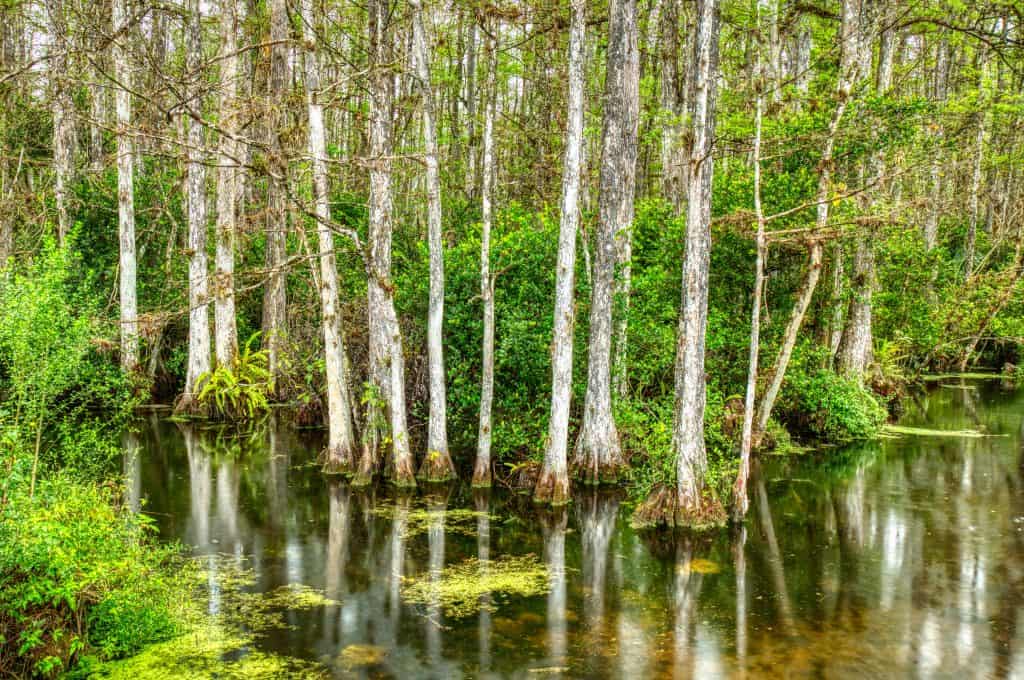
Where Are The Everglades Located?
You can find the Florida Everglades at the southern tip of the state. Taking up the entire southern third of the peninsula, the area is largely depopulated. Instead of residents, you’ll find three national parks.
Originating just south of Orlando, the Everglades extends down the Kissimmee River all the way to the Florida Bay at the tip of the peninsula. Also technically included in the Everglades are the Ten Thousand Islands near Naples and parts of the Florida Keys !
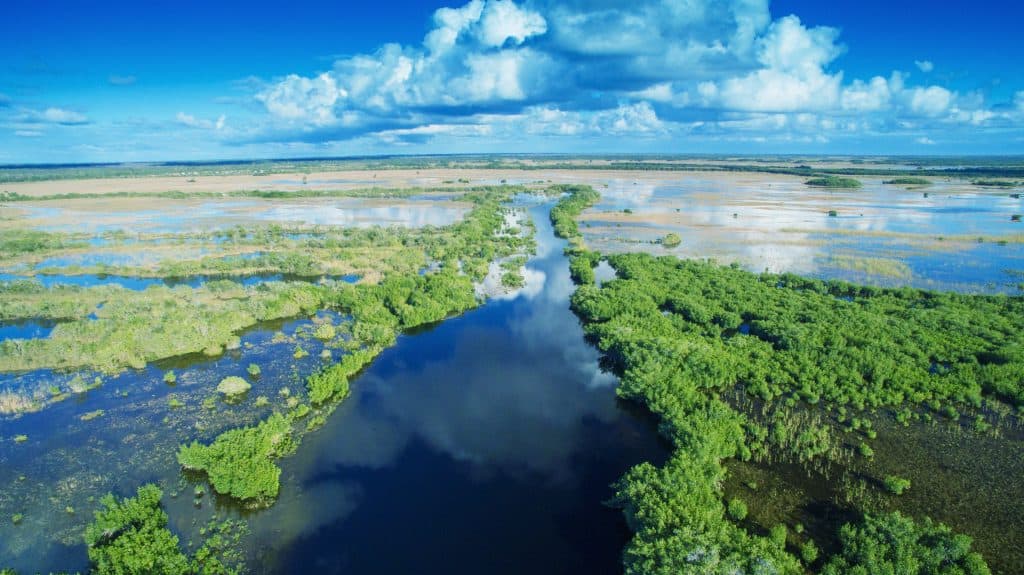
How To Get From Miami To The Everglades
There are three entrances to the Everglades: the north entrance at Shark Valley, the south entrance at Florida City near Homestead, or the northwest entrance at Everglades City on the Gulf Coast.
If you’re traveling from downtown Miami, you can expect only a forty-minute drive! You’ll want to go to the Shark Valley entrance! For the quickest route, simply take I-95 North to exit 3A (FL-836 W to FL-825). From there, turn right onto US-41 West until you hit swamp!
For a more scenic route, you can actually just take SW 8th Street through downtown Miami! You’ll pass through Little Havana and see all of the best Miami attractions . While this route takes longer, it is more scenic. This is perfect if you don’t want to take the expressway.
How To Get Around The Everglades
The easiest way to get around the Everglades is definitely by car. In a vehicle, you can cover the most ground in the least amount of time. Most drivers can explore the entire park in one to two days!
Before you go, make sure to pick up a national park pass. It only costs $25 dollars per vehicle for an entire consecutive week!
Many people will tell you boating is the best way to explore the beauty of the ecosystem, but if you’re not an experienced boater, you might run into problems.
Only the most prepared boaters should attempt to navigate the waterways as a recreational activity. It can be easy to become lost or run aground in park waters! If you don’t use navigational aids and marked channels, you can do a lot of damage to your boat and the ecosystem itself.
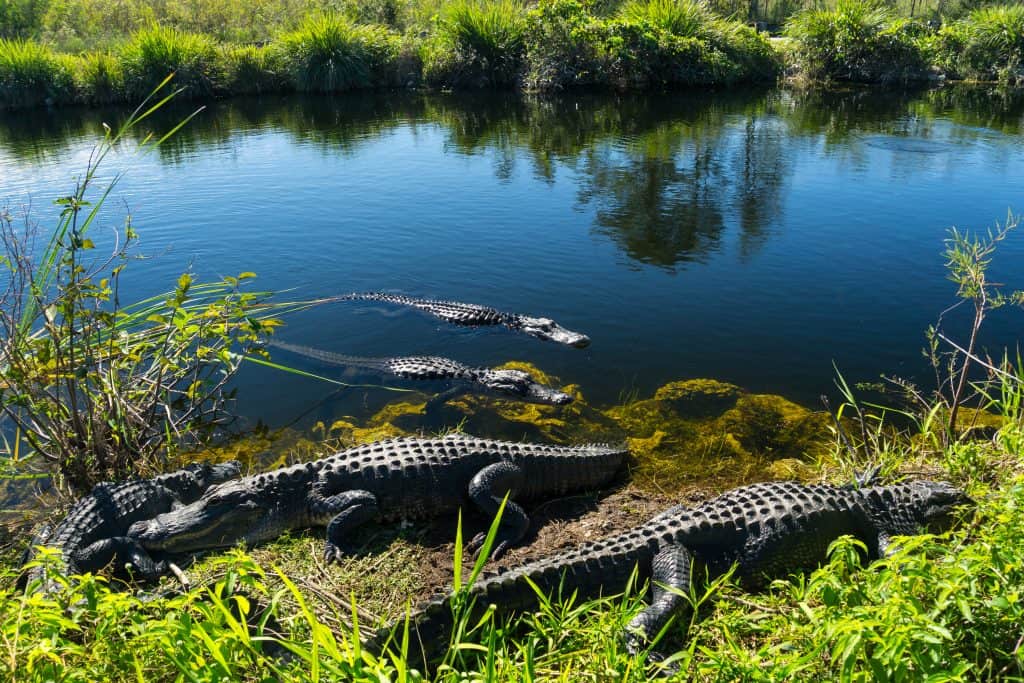
How Long To Spend In The Everglades
Of course, any stay in the Everglades will depend on how much of the park you want to see. For a quick pass just to see everything, a driver could easily accomplish this feat in one to two days.
However many locals will tell you that simply will not cut it! Especially if you want to tackle the hiking trails, experience an airboat tour, or paddle through the waterways on a kayak, you will need more time.
If you really want to fully explore the park, we recommend a full week to see everything. Depending on your activities planned, you can easily spend three to four days on each coast of the park.
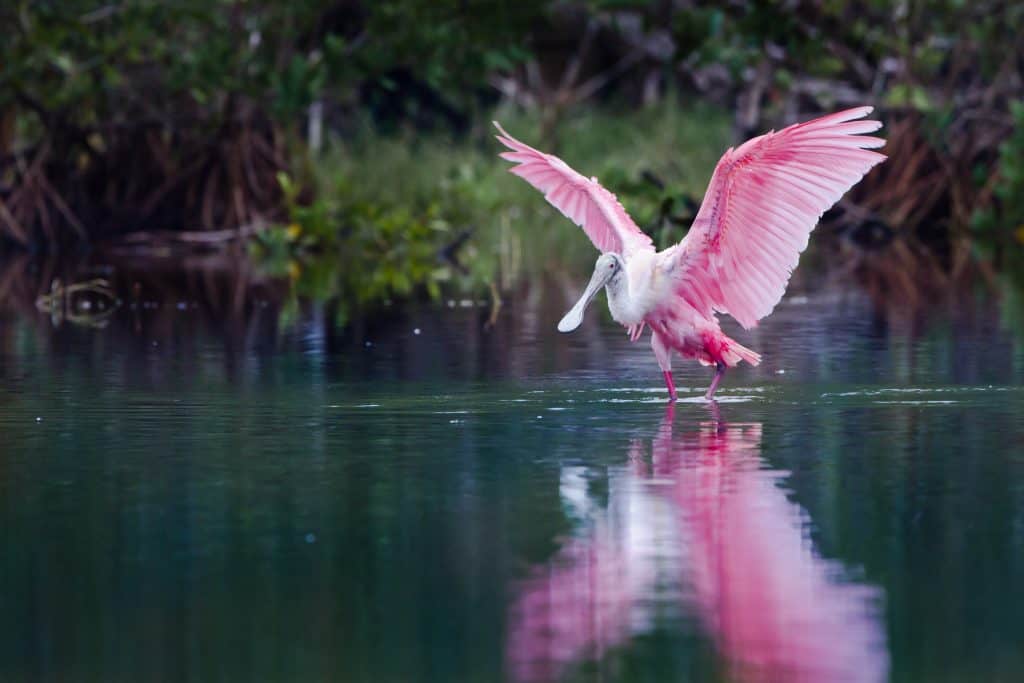
Best Everglades Tours
The Everglades are a big place, and it’s very easy to get overwhelmed. If you’re having trouble deciding what to do in the Everglades, consider checking out a tour, whether it be by foot, by car, or by boat!
Now you don’t have to do any planning of your own! The best part? You’ll still see the best of the beauty of the park in a timely, organized fashion! Taking a tour is certainly one of the best things to do in the Everglades if the idea of going it alone seems daunting.
Everglades Holiday Park
An hour-long narrated boat tour, you’ll learn about the variety of wildlife that inhabits Florida’s famous wetlands. In addition to the boat ride, you will also see a live alligator show and have the opportunity to hold a baby gator!
This is a great comprehensive option, but we recommend attending early in the day, as crowds can dampen the experience! One of the best Everglades tours from Miami, your guide will cover a lot of ground.
Tours operate seven days a week! Boats leave from the park every 20 minutes from 9 AM – 4 PM. Adult tickets cost $35, children’s tickets cost $20, and kids two years and under ride for free!
Shurr Adventures Everglades
If you really want to get the blood pumping, then this three-hour kayak tour of the mangroves of the Everglades is for you! You can spot orchids, birds, and of course alligators as you paddle your way through the mangrove tunnels!
You’ll be led by patient, experienced guides who take the time to educate guests about the ecosystem. Tours depart every day at sunrise, 7:30 and 8:30 AM, 1:30 PM, and sunset. Tickets are $109 for adults and $99 for children.
Shurr Adventures Everglades also offers full-day tours of the mangrove tunnels. You can also take a motorboat tour through the Ten Thousand Islands, among other options.

11 Best Things To Do In The Everglades
Lucky cole’s speakeasy.
The last thing you think about in the Everglades is a bar or restaurant. But for weary travelers willing to do into the depths of the swamps, Lucky Cole is waiting to greet you with open arms.
One of the best things to do in the Everglades, stop by Lucky Cole’s personal home. Off of US 41, about 40 miles from Miami, you’ll eventually see a red mailbox next to old motorcycles and a Lucky Strike sign. You have arrived.
A famed Florida photographer, Cole photographs women with the Everglades as the exotic backdrop. All shoots are directed by his loving wife of many years, Maureen. Together, they advocate women’s empowerment by creating glamorous and sensual photographs of everyday women in various states of undress.
When you visit Lucky Cole and Maureen, expect to be greeted with a smile. You’ll be welcomed with astonishing hospitality, serving cheep beer and homemade venison chili.
Their guests range from locals, Everglades lifers, and anybody that dares to venture this deep into the swamps. Be warned, Lucky only welcomes guests on the weekends. Check his Facebook page to make sure he and Maureen aren’t out on a photoshoot!
Shark Valley
Off of the Tamiami Trail, Shark Valley is one of the best things to do in the Everglades! In the very heart of the Everglades freshwater marks, this is one of the best places to observe Florida wildlife in its natural habitat.
To get there, start at the Shark Valley Visitor Center. Here you’ll find educational displays, a park video, and you can pick up an informational brochure. Inside you’ll find what plants and animals you’re most likely to see!
Next door, you will also find a gift shop where you can pick up essentials and souvenirs. We recommend grabbing bug spray before you head to Shark Valley, and then visiting upon your return. That way you don’t have to lug your souvenirs as you hike!
From the Visitor Center, you can walk or bike along a 15-mile loop trail that leads into Shark River Slough. Halfway up the loop trail is a 65-foot high observation tower!
From the concrete observation tower, you will be rewarded with a panoramic view of the sawgrass marsh. See the untouched grounds as it appeared to natives over 300 years ago.
Make sure to bring your binoculars. If you look down, you’ll be sure to see baby alligators learning to walk as well as Red-bellied Turtles! Keep your eyes to the skies to catch glimpses of Red-winged Blackbirds and Double Crested Cormorants.
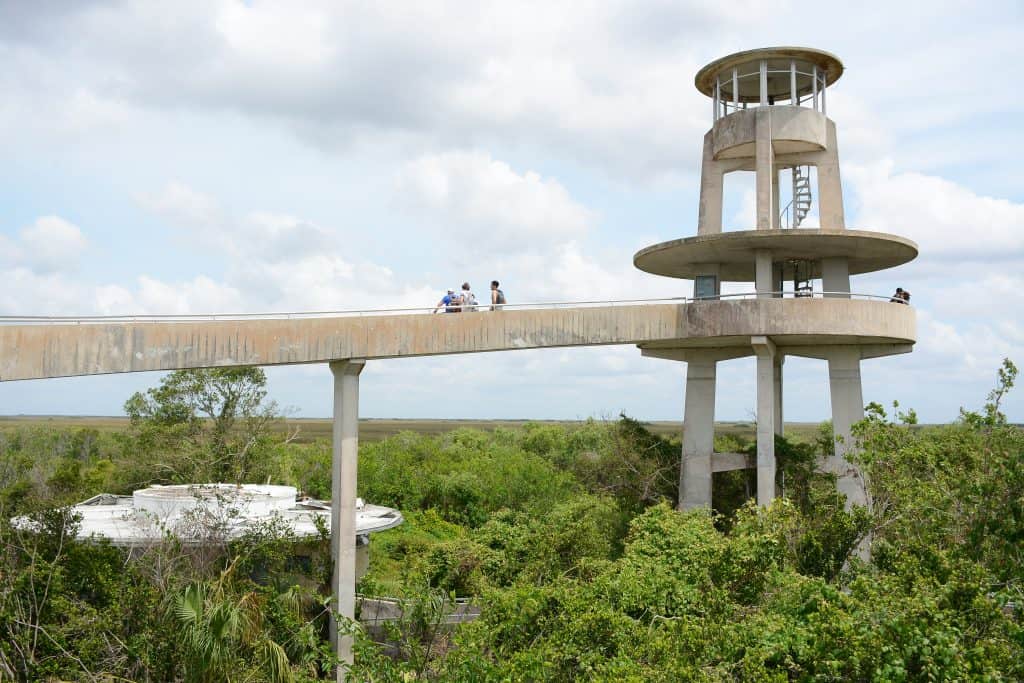
Wilderness Waterway
Calling all kayakers! If you want a paddling challenge, then the Wilderness Waterway is for you, one of the best things to do in the Everglades!
Over 99 miles long, in Wilderness Waterway, you’ll find a navigable recreational waterway, also known as the Marjory Stoneman Douglas Wilderness. With many interconnecting creeks, rivers, lakes, and inner bays, only the most experienced paddlers should tread these waters.
There are many shallow waterways that are only passable at high tide. One pass known as “the Nightmare” is especially difficult to navigate without damaging submerged natural features.
While difficult, the Wilderness Waterway has its merits. You can see shell mounds build by the Calusa people! You can also see Nauti Buoy Chickee, the last remaining private property within the park.
A full trip along the Wilderness Waterway takes an experienced paddler around eight days to complete. Travelers can however use additional route options to extend or shorten their trip.
Around the banks of the waterway, you’ll find beach, ground, and chickee campsites. Permits are required and may be obtained at the Gulf Coast Visitor Center.
Because many hurricanes have passed through the Everglades in recent years, you should always talk with an experienced ranger before embarking on a trip. They will have the most up-to-date information about best routes for your paddling skill level!
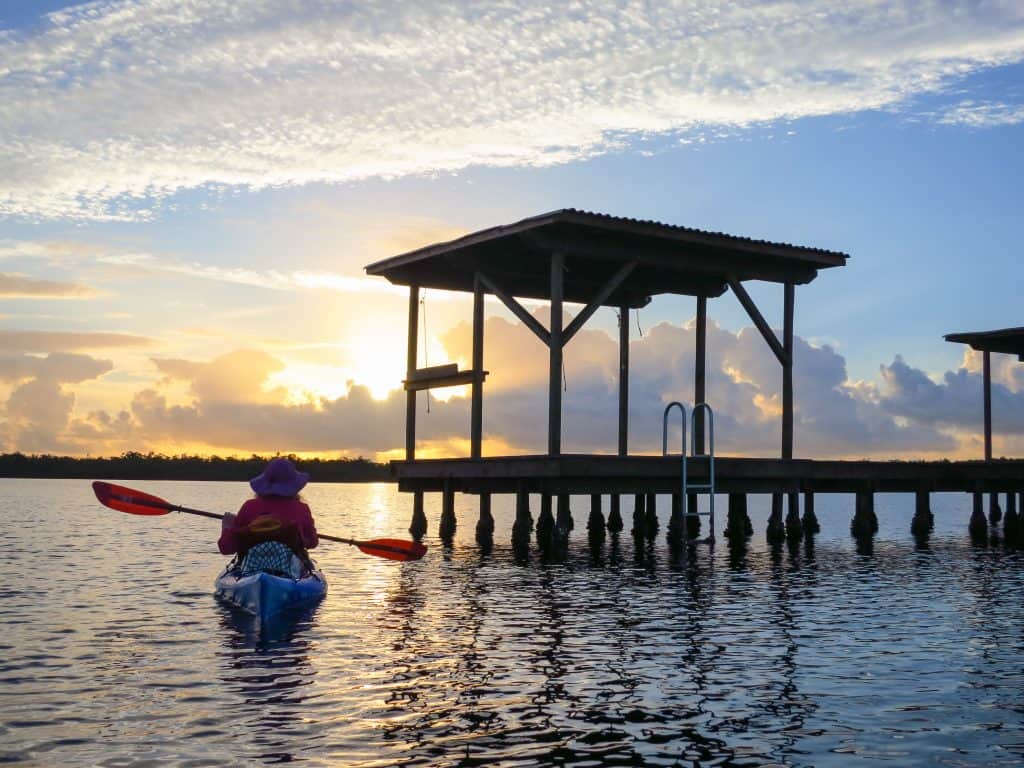
Ernest F. Coe Visitor Center
When you first arrive at the Everglades, you may become overwhelmed by your options. Instead of embarking blindly into the park, make your first stop at the Ernest F. Coe Visitor Center, one of the best things to do in the Everglades to orient yourself.
Here you’ll get an overview of the extensive offerings in the park. Check the map to get a detailed look at what to do and where to go! A wildlife chronology details the native Florida animals you may see that day.
Inside you’ll find educational displays and informational brochures. Special collections by local artists are usually on display. Don’t forget to stay for River of Life, a 15-minute documentary detailing the ecosystems of the park.
Next door you’ll find the bookstore and a small gift shop to pick up essentials and souvenirs! Here you can buy books, guides, camera film, postcards, and of course, insect repellent.
The Ernest F. Coe Visitor Center also provides guided tours by park rangers. Your guides will have a deep understanding of science and a love of the South Florida area. A ranger’s expertise of the animals, birds, and trees will become the highlight of your trip!
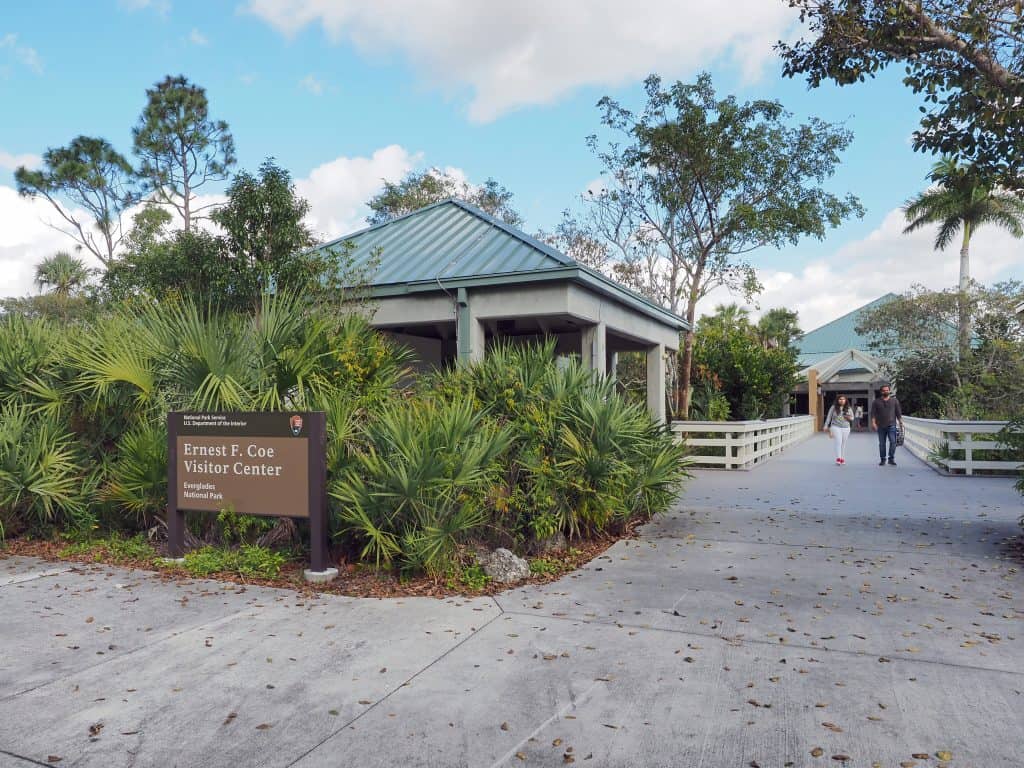
Anhinga Trail
For most visitors, the Anhinga Trail is one of the first glimpses they’ll get of the Everglades National Park. Very close to the Royal Palm Visitor Center, the Anhinga Trail is one of the Everglades’ best attractions.
Just short of a mile, the Anhinga Trail is one of the most accessible in the Everglades, even for novice hikers. Children and dogs are permitted, but parents are encouraged to keep a close eye as predators are nearby.
The Anhinga Trail is one of the best places to see wild alligators . A haven for all Everglades wildlife, you’ll find cormorants, egrets, herons, and roseate spoonbills along the stone wall and trees.
Look for odd-looking clusters of trees! These are pond apple trees that bear fruit. Don’t eat the apples though. They taste like turpentine. If you visit during the summer months, you might see sprays of orchids in the branches.
The path will eventually turn into a boardwalk and later into a larger observation area over the slough. You’ll see alligators drifting through the inky water as well as miles of sawgrass prairies.
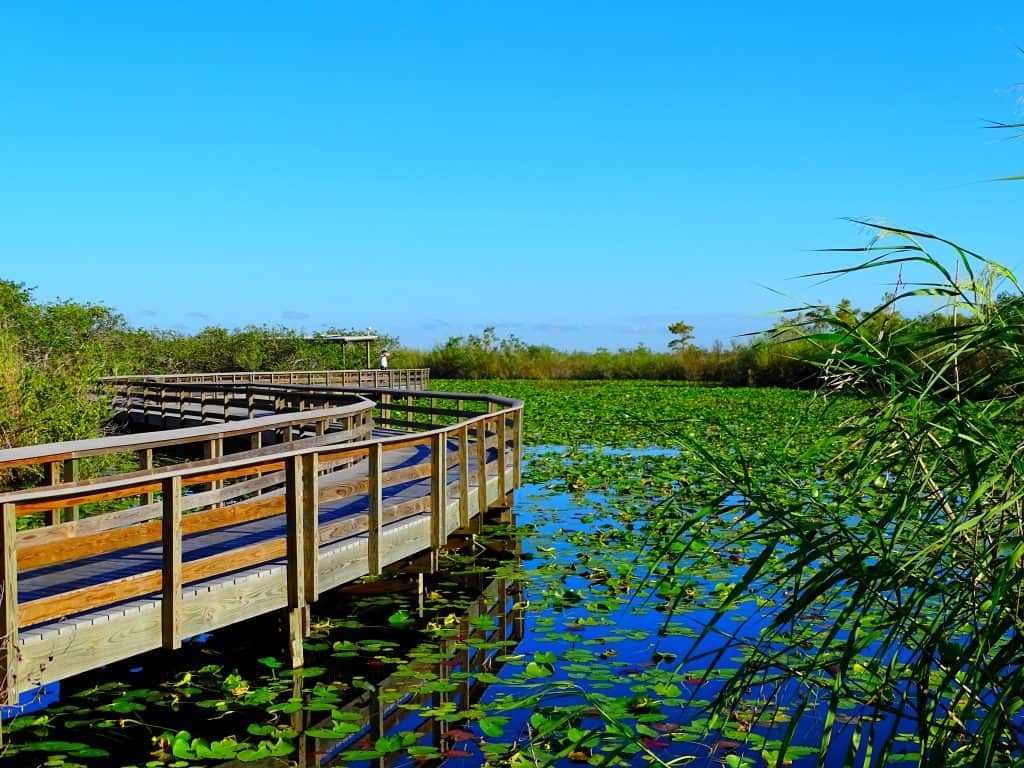
Flamingo Visitor Center
At the southern tip of the Everglades, you’ll find a wide asymmetrical building featuring a long breezeway. This breezeway connects two buildings that overlook the Florida Bay.
This is the Flamingo Visitor Center, one of the best things to do when traveling from Miami to the Everglades. Next door, you’ll find a marina. Here you’ll find a great place to see wild manatees playing and sleeping in the water.
If you’re more of the adventurous sort, you can also rent kayaks and boats here. Spray on your bug spray and take to the water!
Open daily from mid-November through mid-April, you can find rangers to provide you with maps and advice should you need it. This is also where you can obtain camping permits as well.
The center itself is currently under construction due to extensive hurricane damage. When the Flamingo Visitor Center reopens completely, you’ll find updated exhibits and even a new restaurant and lodging!
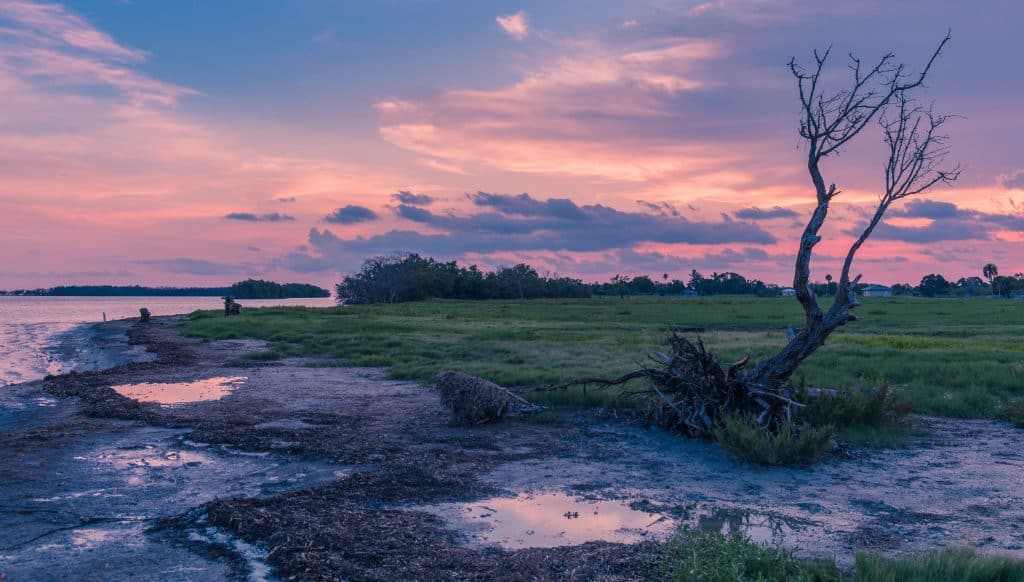
Ten Thousand Islands
One of Florida’s hidden gems , the Ten Thousand Islands are a chain of islands and mangrove islets that can be found near Naples between Cape Romano and the mouth of the Lostman’s River.
Here you’ll find over 230 square miles at the northwest-most corner of the Everglades National Park. With endless swimming and kayaking, a visit to the Ten Thousand Islands is one of the best things to do in the Everglades.
One of the world’s largest mangrove systems, this national wildlife refuge is a paradise for those seeking some peace and quiet. Perfect for experienced paddlers and easy-going tourists, there’s something to do for everyone!
Take a narrated boat tour at the Gulf Coast Visitor Center to learn the islands’ unique environment. The guides will direct your attention to wildlife like bald eagles, hawks, and dolphins playing in the water.
If you love the great outdoors, plan an overnight kayak trip. Choose between Tiger Key or Picnic Key for a view of the brilliant night sky from your own private beach! Sites at the island are limited and must be reserved in advance.
For a more relaxed approach, check out Tigertail Beach on Marco Island, one of the best beaches in Naples. From here, you’ll get a great view of Sand Dollar Island to spy on terns, black skimmers, and sand pipers.

Eat Stone Crabs at Everglades City
At the northwest tip of Everglades National Park, you’ll find a small town of only 500 people. Congratulations, you’ve stumbled across Everglades City, one of the great Florida oddities.
Everglades City was once a popular hub in the late 1970s as part of the marijuana trade. Over the years, after nearly the entire town was indicted in court, the town has found a new item to peddle.
Everglades City is proudly now the Stone Crab Fishing Capital of the world, a much more legitimate way to make a living. Instead of spending a pretty penny on Claws at expensive restaurants in Miami , head to Everglades City for a more casual and authentic experience.
At Grimm’s Stone Crab or Triad Seafood Market, you’ll get stone crabs freshly-fished out of the water. As you dine with the waterfront views of the Everglades, strike up a conversation with a local. We promise you’ll get a great old Florida story.
Especially if you’re visiting the Everglades from the northwest part of Florida, stop off at Everglades City. This is one of the best things to do in the Everglades, especially if you want an authentic meal!

Big Cypress National Preserve
During the rainy season, an expansive canopy of Big Cypress trees covers the Tamiami Trail. This will be the most scenic highlight of your drive through the park! The Big Cypress National Preserve is one of the best things to do in the Everglades.
For those that don’t want to get hot and sticky in the swamp and avoid mosquito bites, you’re in luck. The Big Cypress National Preserve is one of the best places to see the Everglades National Park from the comfort of your own vehicle.
As you drive, you’re likely to see egrets and herons soaring through the sky. Completely untouched, you’ll drive through an old Florida wonderland, seeing firsthand what indigenous people who made there home here once saw.
To get a closer look at the flora and fauna, stop at the Big Cypress Visitor Center. On a boardwalk along a large canal, you’ll see gators sunning and birds flying overhead. Remember never to feed the alligators, lest you want to lose a limb!
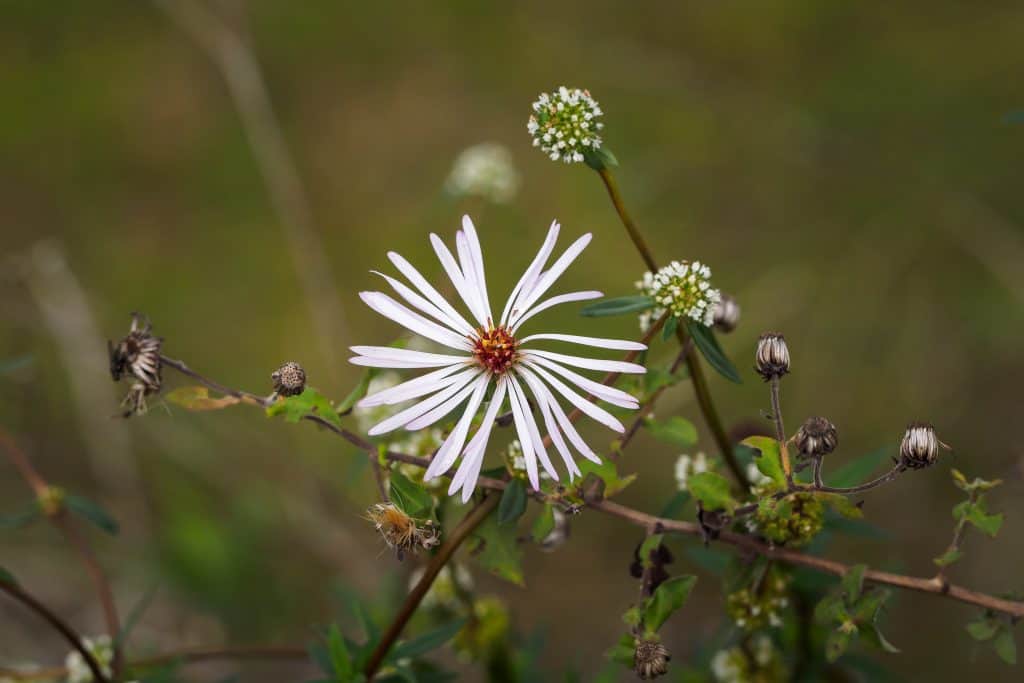
Snake Bight Trail
For a true walk on the wild side, brave the Snake Bight Trail. Don’t let the name fool you, while snakes like Burmese pythons and poisonous trees are found in this area, you will be safe as long as you stick to the trail.
We’re warning you now, the five mile trip from Main Park Road to Snake Bight has the worst mosquitos in the park. So make sure to wear lots of bug spray. We warned you!
But no risk, no reward, right? To get there drive north from the Flamingo Visitor Center to park on the grass after the “Rowdy Bend Road” sign. Start at the trailhead to walk or bike through a lush tropical forest.
The trail is very tight as it travels through a tunnel of Cypress trees. Don’t veer from the path as there are poisonous manchineel trees and Burmese pythons lurking in the forest nearby.
The air smells salty from the coast as the path changes into a boardwalk. Look out for the Bromeliads clinging to the buttonwoods!
After two miles, you’ll have reached your destination and reward. At the observation platform, you’ll have a sweeping view of all of Snake Bight and the Florida Bay. If you look closely, you’ll see flamingos perching in the mud if you visit during winter.

Pa-Hay-Okee Lookout Tower
To truly get up close and personal with the marshy ecosystem, try the very accessible trail at Pa-Hay-Okee. Named after the Seminole word for River of Grass, you’ll find a short boardwalk leading to a tall observation tower.
To get there, follow Main Park Road from the Ernest F. Coe Visitor Center for 21 miles. Enjoy the scenic drive before turning right at the sign for Mahogany Hammock to reach the trailhead.
Because the entire trail is aboardwalk, Pa-Hay-Okee is very kid-friendly. While the mosquito situation isn’t as bad as other areas like Snake Bight, you’re still going to want to protect yourself. As you walk down the boardwalk, you’ll walk over the gorgeous sawgrass prarie.
When you climb the staircase to the Observation Tower, you’ll ascend past Cypress trees on a small island. From your shaded perch, you will be able to see the incredible vistas across the prarie.
If you look down, you’ll see the only water source for much of the wildlife in the dry season. To get back to your car, simply follow the boardwalk ramp through the Cypress canopy down to the forest floor.
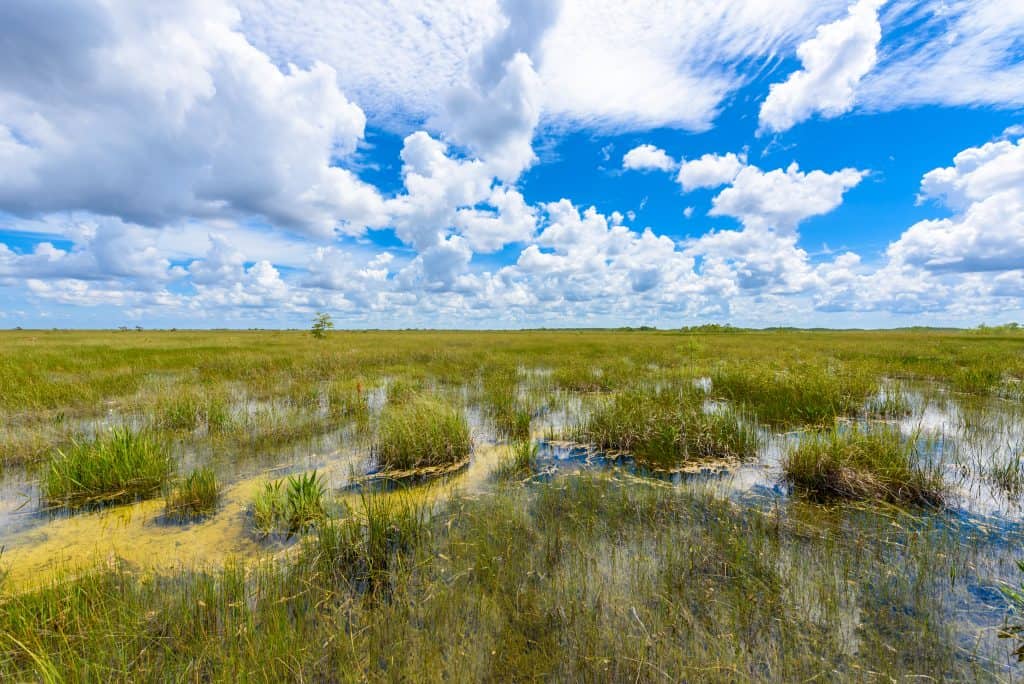
Did You Find This Post Helpful?
If so, we would love to keep in touch! We enjoy seeing photos and comments about your experiences in Florida! You can follow us on Instagram and we will repost your photos on our feed and comment too! Just tag us at @floridatrippers and hashtag #floridatrippers. We can’t wait to see your travels!

National Geographic content straight to your inbox—sign up for our popular newsletters here

An egret takes flight in Everglades National Park.
Florida's Pristine Parks: Everglades National Park
Get more out of your Everglades National Park visit by exploring must-see parks, preserves, and refuges nearby.
Spanning 1.5 million acres of freshwater and coastal prairie, marsh, mangroves, pine and cypress woods, and the waters and islands of Florida Bay, Everglades National Park contains the largest subtropical wilderness in the United States. For first-time visitors, the park’s size and relatively inaccessible terrain can make it difficult to figure out where and how to experience the Everglades in a meaningful way. This main entrance, located on the eastern edge of the park in Homestead, is a convenient option for a half- or full-day visit or for planning a backcountry trip. Stop at the Ernest Coe Visitor Center (open 365 days a year) to watch the orientation films, pick up maps and brochures, and participate in ranger-led programs. From here, it’s only a four-mile drive west to the Royal Palm area’s two accessible trails—the Anhinga (0.8-mile loop) and the Gumbo Limbo (0.4-mile loop). Alligators, turtles, herons, egrets, and, yes, anhingas, are regularly spotted when walking the first trail, one of the most popular in the park. On the less traveled Gumbo Limbo, you’re more likely to see songbirds and butterflies. Inside Tip: Arrive prepared to go slough slogging, off-trail hiking through the shallow, freshwater slough—the Everglades' iconic “river of grass.” Standard slough-slogger gear includes mosquito repellent; water; sturdy, waterproof hiking boots or trail-running shoes; and clothes you don’t mind getting muddy and wet.
When to Go: December through March is the best time to visit due to the cooler temperatures, dry weather, increased ranger programs, and abundant wildlife-viewing opportunities (particularly along the Anhinga Trail).
Must Dos: Walk the Anhinga Trail. Take a scenic 38-mile (one-way) drive along the main park road from the Ernest Coe Visitor Center to the Flamingo Visitor Center on Florida Bay. Stop at the Long Pine Key picnic area (six miles from the main entrance) to park, picnic, and hike or bike part of the 43-mile pinelands trail network. Just before reaching Flamingo, pull off to hike the Snake Bight Trail. The 1.6-mile (one-way) trail leads to a viewing platform overlooking a bight (small bay) on Florida Bay. Best Bet: December to April, join a ranger-led tour of the Nike Missile Base , an abandoned antiaircraft missile site built in response to the 1962 Cuban Missile Crisis.
Helpful Links:
- Everglades National Park
- Ernest Coe Visitor Center
- Plan Your Visit Videos
Fun Fact: The 1960s CBS television series Gentle Ben , starring Dennis Weaver as Everglades game warden Tom Wedloe, included many scenes filmed on location in the national park. The series’ namesake was the pet black bear of Wedloe’s young son (played by director Ron Howard’s brother Clint). While the short-lived (1967-69) series was lauded for promoting conservation, it also received criticism for portraying a wild, adult bear as a tame, lovable, and approachable animal.
Nearby Nature
The everglades’ flamingo visitor center.
The Everglades’ Flamingo Visitor Center is located on Florida Bay, 38 miles south of the Ernest Coe Visitor Center. From late November through April, this section of the park buzzes with water-based tours and rentals (boat, kayak, and canoe) and wildlife. Look for alligators, American crocodiles, and the occasional manatee in the Florida Marina boat basins. Outside the visitors center, watch wading birds gather on the exposed mudflats at low tide. To maximize the wildlife views, paddle one of the canoe trails leading inland from Flamingo or (if you’re an experienced paddler) out into Florida Bay. Get maps and ranger advice (mid-November to mid-April) in the visitors center. Rent canoes at the marina. And apply plenty of mosquito repellent and sunscreen. Inside Tip: Free guided canoe trips are typically offered from December to March and fill up fast. Call the park to make reservations and to get the most current schedule of programs available. For unguided trips, the Nine Mile Pond shortcut route (a 3.5-mile loop) is a smart choice for beginners.

Visitors approach the 65-foot Shark Valley observation tower in Everglades National Park.
Photograph by Wim Wiskerke, Alamy
Shark Valley
- Nat Geo Expeditions
Shark Valley , located off U.S. 41 (Tamiami Trail) near Miami, is the best area in Everglades National Park for scenic bike rides (rentals available). The most popular attraction here is the naturalist-led tram tour . Pedaling instead of riding the flat, 15-mile Tram Road loop provides a more intimate view of the Shark River Slough, the freshwater heart of the Everglades. Plus, when you bike you can go at your own pace and spend extra time perched above the park on the 65-foot observation tower (located at the southern end of the loop). Inside Tip: Dry season (generally December to May) is the best time for wildlife viewing. Since Shark Valley is a freshwater source year-round, alligators, turtles, waterfowl, and other animals congregate here when water is scarce in other parts of the park.

A fan boat ferries passengers on a waterway in Everglades City.
Photograph by Bill Bachmann, Alamy
The Gulf Coast Visitor Center
The Gulf Coast Visitor Center is located on the northwestern edge of the park in Everglades City. This is the starting point for the 99-mile Wilderness Waterway Trail to Flamingo (experienced paddlers only). Also accessible from Gulf Coast are shorter, scenic canoe trails where you can paddle creeks and shallow coastal estuaries to look for fish, alligators, wading birds, and other wildlife. Boat, kayak, and canoe rentals and boat tours are available. Inside Tip: Since tides, weather, wind, and passing powerboats can make any paddling trip challenging, talk with the rangers and review the park’s Wilderness Trip Planner before heading out.
Related Topics
- NATIONAL PARKS
You May Also Like

Everything you need to know about Everglades National Park

An ambitious new Florida trail links two U.S. national parks
For hungry minds.

A wildlife odyssey through Florida's Everglades and Key West
Off-grid adventures: explore the national parks of the pacific northwest.

How to visit Biscayne National Park

10 national parks to avoid the summer crowds

These are the 10 best U.S. national parks to see wildlife
- Environment
History & Culture
- History & Culture
- History Magazine
- Gory Details
- Mind, Body, Wonder
- Paid Content
- Terms of Use
- Privacy Policy
- Your US State Privacy Rights
- Children's Online Privacy Policy
- Interest-Based Ads
- About Nielsen Measurement
- Do Not Sell or Share My Personal Information
- Nat Geo Home
- Attend a Live Event
- Book a Trip
- Inspire Your Kids
- Shop Nat Geo
- Visit the D.C. Museum
- Learn About Our Impact
- Support Our Mission
- Advertise With Us
- Customer Service
- Renew Subscription
- Manage Your Subscription
- Work at Nat Geo
- Sign Up for Our Newsletters
- Contribute to Protect the Planet
Copyright © 1996-2015 National Geographic Society Copyright © 2015-2024 National Geographic Partners, LLC. All rights reserved

Everglades National Park: 2024 tips for visitors
By: Author Bonnie Gross
Posted on Last updated: March 23, 2024
Everglades National Park reveals its magic and beauty when you experience it up close. It doesn’t look like much from a car windshield.
This Everglades National Park visitor guide is designed for the first-time visitor and suggests ways you can get to know the Everglades and see some of its famous wildlife.
It is based on four decades of visits by a South Florida resident who loves this land and these waters. I’ve paddled every trail in Everglades National Park and hiked nearly every trail. (Some feature shoe-sucking mud and even the park rangers don’t recommend them!)
We’ve updated for the 2024 season , and there are some significant changes — admission is up to $35 for vehicle (from $30) and the Flamingo area has a terrific new visitor center and lodge, making it an even more appealing destination.
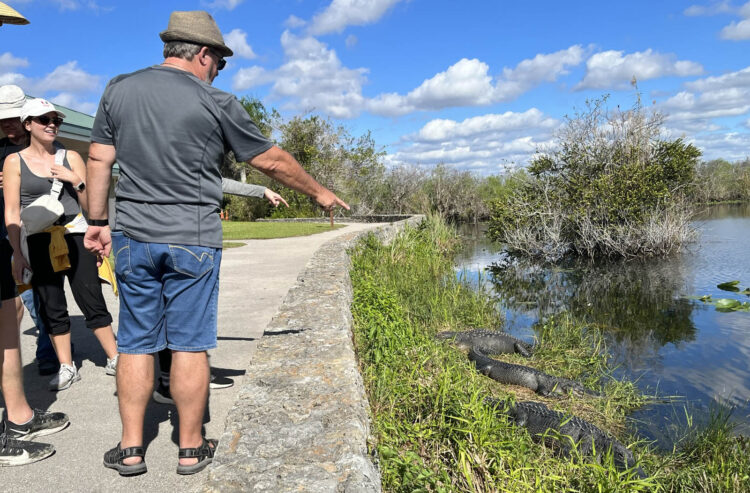
Which part of the Everglades should you visit?
Your first decision in visiting the Everglades National Park is which entrance to use — there are three, they are hours apart and you cannot drive through the Everglades from one to the other.
The essential experience in this 1.5 million acre World Heritage Site is the opportunity to observe Everglades wildlife up close and appreciate the vastness and diversity of this river of grass. You can do this at either Shark Valley or the Homestead national park entrance.
The Shark Valley entrance to Everglades National Park is off the Tamiami Trail (US 41) directly west of downtown Miami. Here’s a good look at how to walk, bicycle or take the tram on the 15 mile Shark Valley trail. We highly recommend the experience of biking in Shark Valley. In recent years, the bird and alligator sightings have actually been better along Shark Valley than from the Homestead entrance.
Shark Valley is an easy day-trip from Miami or Broward County. It makes a great Everglades outing, and if you have time to go only here, don’t feel you’ve missed out by not visiting the Homestead entrance.
If you have time and want to explore the beautiful Thousand Islands area off the Gulf Coast at Everglades City, this area is a great place to kayak. But this entrance to the park offers a different experience from the other two. (If you have time, do them all.)
If you go to the Gulf Coast , one of the most popular experiences is taking the Ten Thousand Islands boat tour . Until fall of 2024, it will be launching from a temporary location two miles north of the Gulf Coast Visitor Center because of reconstruction of the visitor center. (The launch site is on DuPont Street, which you reach on the right as you are coming to town before your cross the bridge into Everglades City, but do book ahead.)
The site of the Gulf Coast Visitor Center and its kayak launch will close to the public April 1 and is expected to open by the end of the eyar. Alternate kayak launch sites in Everglades City and Chokoloskee are available at the Rod and Gun Club, Outdoor Resorts of Chokoloskee and the Chokoloskee Island Park and Marina. Visitors should contact these sites directly for parking and launch fees.
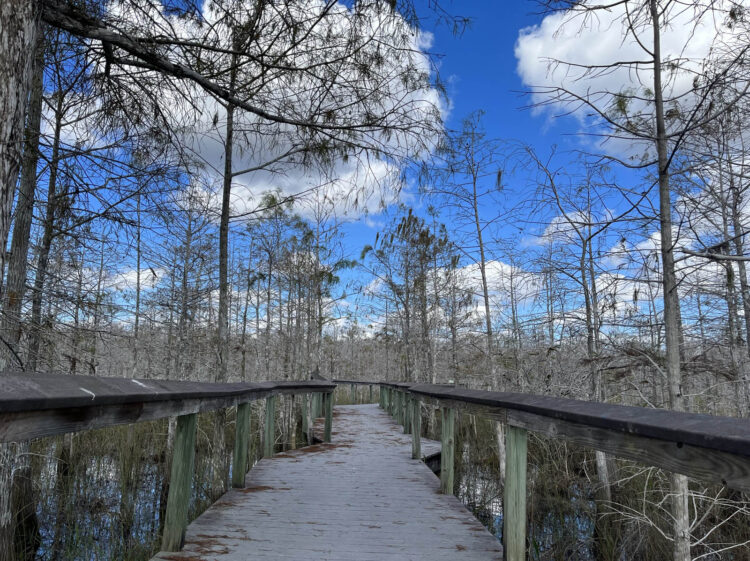
Homestead entrance at Everglades National Park
The Homestead entrance to Everglades National Park is half-way between downtown Miami and the Florida Keys. It’s a route into the interior of the park with many more options to stop and explore. It’s easy to spend more time here than Shark Valley because there are more areas to explore, trails and waterways.
If you choose the Homestead route, pack a picnic lunch (there will be no food service in the park until your reach Flamingo 38 miles away) and plan to spend the day — or two or three.
For an in-depth visit to the Everglades, you’ll need to either camp in the park, stay in an eco-tent in Flamingo (a “glamping” experience where you don’t need camping gear) or stay in the new Flamingo Lodge.
Coe Visitor Center at Everglades National Park
The first stop, even before entering the Everglades park and paying your $35 per car admission (good for seven days), should be the Ernest F. Coe Visitor Center , because it offers well-designed interactive exhibits that help you appreciate what you are about to see. There’s a very good 15-minute film “River of Life” in the theater.
Be sure to get maps here and ask any questions you have about planning your visit. We’ve found the Everglades park staff and volunteers here extremely helpful and knowledgeable.
Be sure to check the schedule of ranger-guided programs . From mid-December to the end of March, these range from 50 minute walks through interesting sites where you’ll have an expert to identify plants, birds and animals to bike rides, canoe trips and slogs through the slough. This is a good way for first-time visitors to learn about this unique environment and these experiences may end up being your Everglades favorites.
Because of the size of the park, there are separate schedules for ranger programs at the Coe Visitor Center (where you enter the park) and at the visitor center at Flamingo.
Some highlights of ranger programs at the Coe Visitor Center:
- At 2 p.m. daily, a ranger leads a free Wet Walk through the river of grass. You need reservations, plus the right clothes to get wet — lace up shoes, socks, long pants, all of which will get wet and muddy. Kids must be at least 12. You also need reservations. Call ahead 305-242-7700 or register at the visitor center. (Size is limited.)
- At 2 p.m. daily, a ranger leads a guided tour of the historic Nike Missile Site. (More on this below.)
- Here’s a list of 2024 programs at the Coe Visitor Center, Dec. 15, 2023 – March 31, 2024.
The Anhinga Trail: Your ‘must do’ in Everglades National Park
Four miles after entering the park you come to the one “must do” of the Everglades visit — the Anhinga Trail at Royal Palm . This is most reliable place to see alligators and Everglades wading birds surprisingly close within the Everglades. (Note: Mid-winter to spring is the best time to see a profusion of wildlife.)
Before it became a national park in 1947, this was Royal Palm State Park and it was this remarkable site teeming with wildlife that grabbed the attention of the women (and it WAS women) who led the way to Everglades preservation.
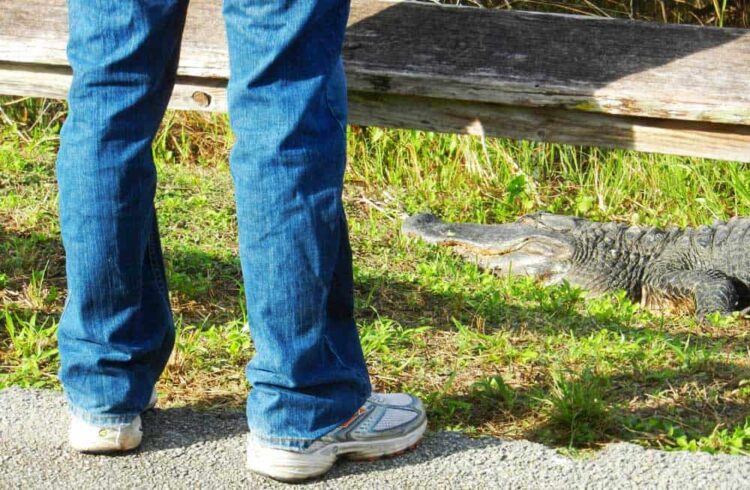
The Anhinga Trail is an easy .8 mile paved and boardwalk trail. I have visited many times in winter and have never failed to see at least one alligator clearly and close, and sometimes a few dozen.
A range of Everglades birds — great blue herons, snowy egrets, cormorants, anhingas, moorhen, coot, wood storks — are often visible. During spring, anhingas nest in trees right next to the boardwalk.
Some may think this trail is a little too Disney-like, because it requires so little effort and the animals seem almost tame. You will see families, strollers and wheelchairs, photographers with huge long lenses and you’ll hear more people speaking other languages than English.
To me, the accessibility of this spot is beautiful; it guarantees a large number of people will have the Everglades experience and be convinced it’s worth preserving. And the animals here really are wild!
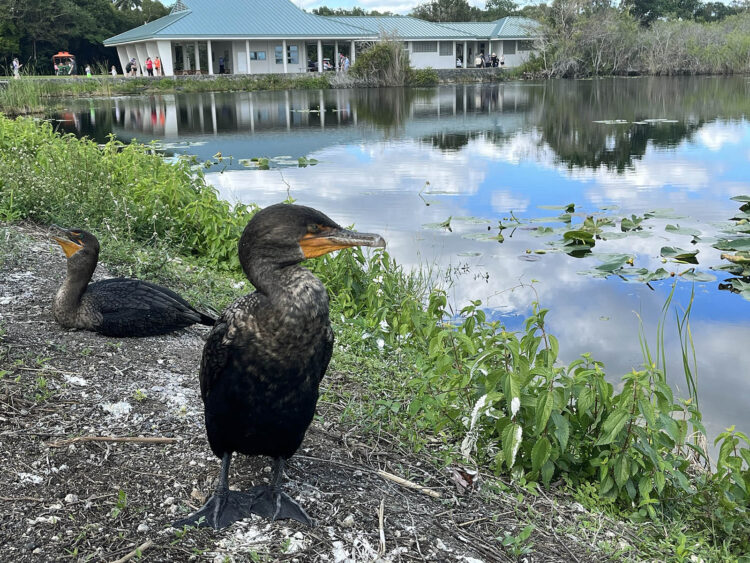
A ranger in the visitor center made an interesting observation on a recent visit: Sightings of wildlife along the Anhinga Trail have not been as profuse in recent years as Everglades restoration has brought more water into the glades, he said. He used to count 40 or 50 alligators along the trail; now he’s more likely to see a half dozen.
The concentrated wildlife was a function of animals seeking rare pockets of water during the dry season; those pockets of water are a less rare, thanks to restoration work — a good thing for wildlife!
At Royal Palm, there is another short trail, the Gumbo Limbo Trail. While a pleasant walk through a vegetation typical of a dryer part of the Everglades, for first time visitors, I’d recommend skipping this one and driving down the main road a bit.
Tip : I always take visitors on the Anhinga Trail. In fact, my recipe for “one day in the Everglades” includes these ingredients: a fruit milkshake at Robert is Here on the way into the park, a stop at the visitor center, a walk on the Anhinga Trail and then a walk on two or three short trails along the road described below. (These trails are accessible to wheelchairs and strollers.)
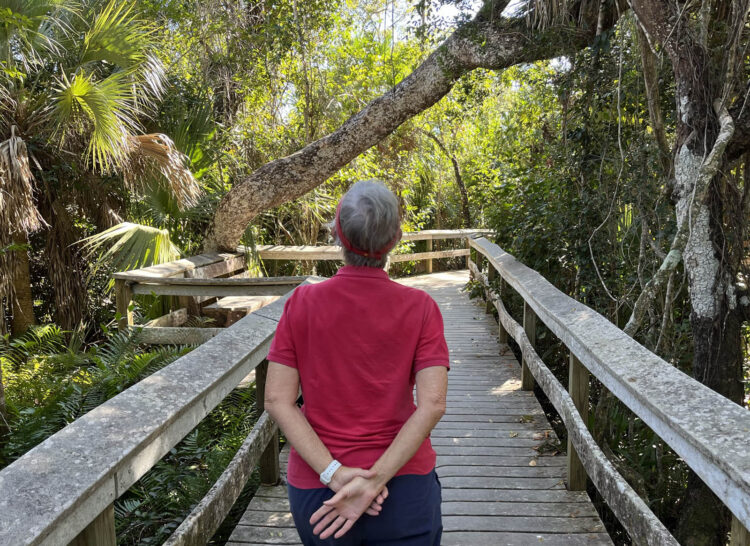
Stops along the main road in Everglades National Park
Along the main Everglades road, there are a series of stops with short walks that round out your experience. Most people don’t have time to do it all, so I would recommend you choose perhaps two or three of these:
The Pinelands Trail is a half-mile walk, this time through another environment, a typical Florida pine forest. A longer trail is nearby, starting near the Long Pine Key picnic area (which is very nice place for stop for the picnic you packed.)
The Pa-hay-okee Overlook . The observation tower here gives you a chance to appreciate the grand sweep of the Everglades and dwarf bald cypress trees. It is beautiful in late afternoon light.
The Mahogany Hammock Trail . This half-mile boardwalk takes you through the sort of jungly Tarzan-movie setting that many people come expecting at the Everglades. It’s a good way to see what a difference a few inches of elevation makes. (A hammock is a tree island where slightly higher ground leads to a profusion of trees.)
Look and listen: We’ve seen a barred owl here on several occasions. It’s a shady trail; good for warm days. That mahogany tree? It’s the largest living mahogany specimen anywhere!
West Lake: This is a good stop if you want a place to picnic . It’s 30 miles beyond the Homestead entrance. It reopened in early 2022, better than ever now that 2017 hurricane damage has been repaired. This stop has only a few covered picnic tables and a restroom.
There is also a boardwalk a quarter mile through the mangroves to an overlook at the lake’s shoreline, where you see trees damaged by that 2017 storm. (This trail can be buggy, so be prepared.) There is also a boat ramp, which is the launch site for the West Lake Canoe Trail, which hugs the southern shore of the big lake and is eight miles long one way.
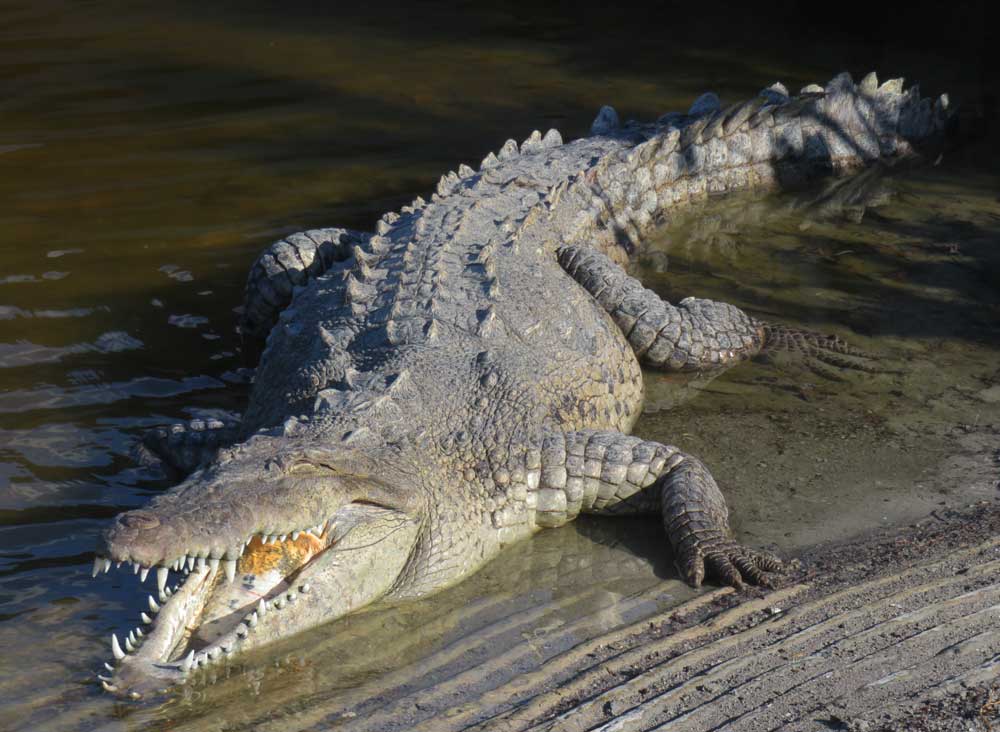
The end of the road: Flamingo
The road continues to Flamingo, where it ends at Florida Bay .
Should you drive all the way to Flamingo? You can have a great Everglades visit without it and it is far — 38 miles from the park entrance.
If you have the time, though, Flamingo has some unique offerings, specifically, reliably good opportunities for observing wildlife you won’t see elsewhere in the park and a terrific new visitor center.
The wildlife here is remarkable. A dozen manatees make the marina basin their place to hang out and are frequently seen. Crocodiles — rarer and more endangered than alligators — are often present in the waters around the marina. The bird life is extensive. An osprey builds a nest right in the middle of the busy marina every year where visitors see mom, dad and chicks living their osprey lives perhaps 20 feet away.
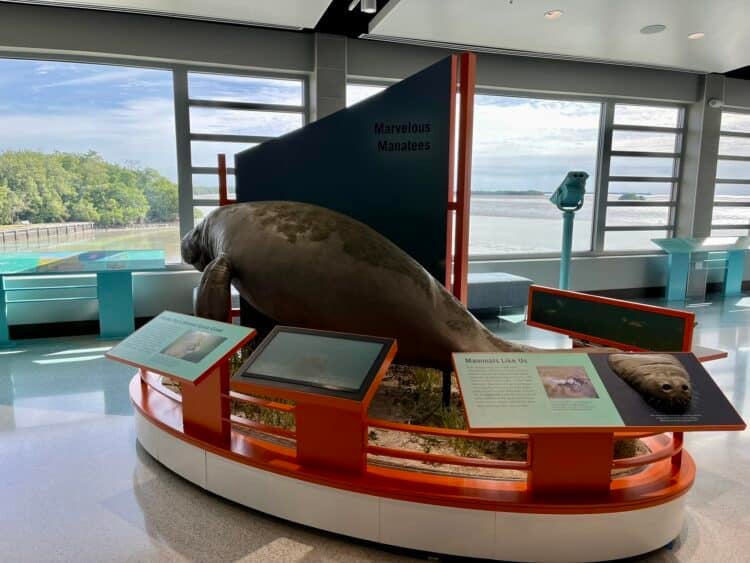
Newly opened just in time for the 2024 season is the beautifully restored 1957 pink mid-century modern Guy Bradley Visitor Center. The excellent exhibits help you understand and appreciate the animals and ecology of the Everglades. But the best part are the huge picture windows overlooking Florida Bay. Try to visit at low tide because the mud flats visible from here fill up with all sorts of birds and the free high-powered binoculars make it easy to view them.
When you’re in the Flamingo area or on your way there, check for birds at West Lake , Mrazek Pond and Eco Pond. (At Eco Pond, you can take a very nice short walk around the pond and gain various vantage points. When birds are present, wildlife photographers abound.)
The Flamingo area has its own schedule of ranger programs. Highlights of the witner programs, include:
- Every day at 8:30 a.m. a ranger leads a free birding walk at a nearby location where something interesting has been seen.
- At 8:30 a.m., every day but Thursday, a ranger leads a three-hour kayak trip into Florida Bay. It’s free and kayaks are provided.
- Here’s the schedule of Flamingo ranger programs offered Dec. 15, 2023 to March 31, 2024
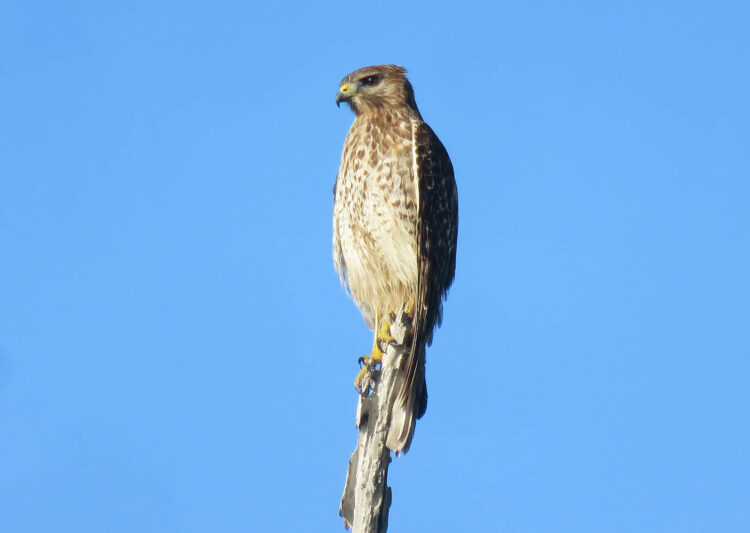
Staying at Flamingo in Everglades National Park
Accommodations and marina activities at Flamingo are managed by the concessionaire Flamingo Adventures , with whom you can book boat tours and rent kayaks, skiffs and bikes. You can even rent houseboats . While expensive, we loved our houseboat experience; read about it here.
The Flamingo Lodge , which opened in November 2023, has four buildings with a mix of studio, one-bedroom, and two-bedroom units, all featuring kitchenettes, balconies, and fabulous views of Florida Bay.
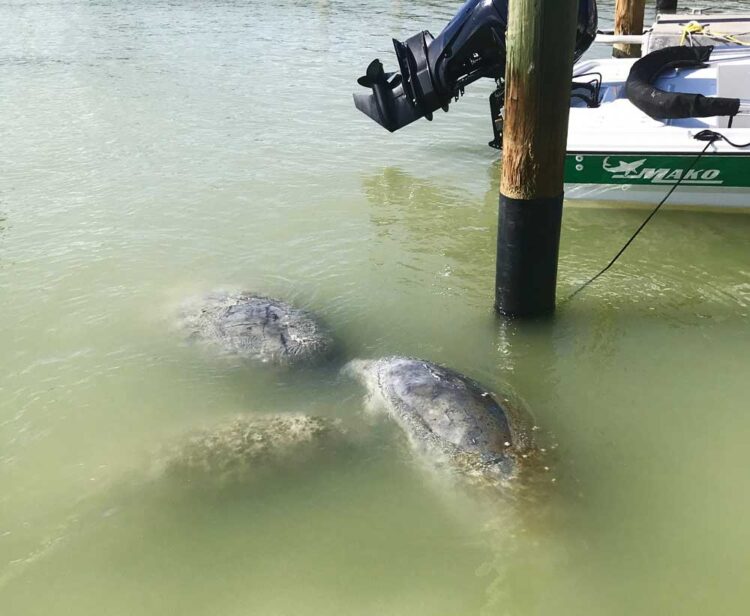
These buildings and a new restaurant are constructed of repurposed shipping containers on stilts. The lodge is located between the visitor center and the campground. It’s not cheap; national parks never are. Rates begin at $159 for the studio in the “low season” in summer and $259 in the winter. There are 24 rooms and four are ADA accessible. Here’s our review of Flamingo Lodge.
Note: During the winter season, the Flamingo lodge has a two-night minimum.
The eco-tents are a cross between tents and cabins. Guests share a central bathroom facility, like at a campground, but stay in a cabin-like structure with electricity, beds and linens. Here’s our review of the eco-tents in Flamingo. Rates for the eco-tents vary by season. They are $95 a night in winter 2023 and we had no trouble getting a last-minute spot on a weekday in January 2023. Without furnishings, the screen-enclosed tents are rented for half price off season.
For all lodge, camping, eco-tents, houseboats and boat rentals, go to Flamingo Adventures .
Here’s our guide of things to do in the Flamingo area , including kayaking into Florida Bay and hiking trails.
Tip : As you head out of the Everglades at day’s end, if you have time, stop back at the Anhinga Trail. The alligators that look dead in the noon sun become active at dusk, and it’s a thrill to see them silently glide through the water with only their tail gently moving to propel them. Also, the walk is quieter and less crowded. On Sunday, Tuesday, Thursday and Saturday in winter, a ranger leads a guided walk at 7:30 p.m. at the Anhinga Trail.
More in-depth Everglades National Park experiences
Since the Everglades National Park admission is $35 for seven days, a multi-day visit is economical. Here are ideas for things you might do if you have additional time.
The non-profit Everglades National Park Institute offers several activities for a fee, including cypress dome wet walks, a Florida Bay kayak outing, an all-day guided tour of the Everglades and more.
Historic Cold War Nike base. This is a popular tour for history lovers and draws a different group of visitors to the park. Prompted by the 1962 Cuban Missile Crisis, the U.S Army built a base here with nuclear missiles and featuring high security. The decommissioned base is well-preserved and includes a refurbished 1960 Nike Hercules missile. Here’s my report on the fascinating tour, offered at 2 p.m. every day during the winter season.
Best Everglades canoe and kayak trails: Bring your canoe or kayak or rent at the marina at Flamingo or from Nine Mile Pond, a five mile loop through a vast shallow sawgrass marsh dotted with mangrove and tree islands. (You can reduce this loop to 3.5 miles by taking a shortcut noted in the article.) The Everglades National Park Institute also offers a guided tour of Nine Mile Pond.
If you’re on your own and it’s not too windy, you can kayak along the shore of Florida Bay by bringing your own or renting kayaks at the Flamingo Marina. Details are in our Flamingo guide.
For a more adventurous kayak-camping trip that doesn’t require reservations far in advance, I’d recommend canoe-camping Flamingo to Cape Sable . It’s 11 miles and you camp on a wilderness beach. (But no swimming: Crocodiles!)
The ultimate Everglades adventure — not for everyone — is paddling the Wilderness Waterway. This is a multi-day camping trail that requires you to arrange livery service to drive you back to your starting place and car. Here’s the park service’s brochure on the trail.
Boat tours at Flamingo : The marina at Flamingo offers two boat tours — one into the inland back country and one into Florida Bay ($40 adults; $20 kids). Both include naturalist guides who point out and identify wildlife. Details .
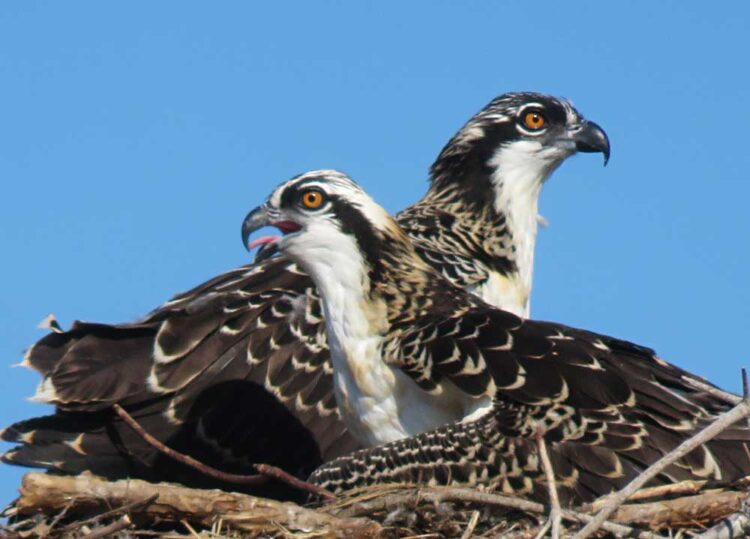
Free admission to Everglades National Park via the Homestead National Park Trolley
FREE admission to the park is available on winter weekends if you take the Homestead national parks trolley system. It’s a really good deal.
If you arrive by trolley, you will have limited options within the park, but it brings you to some of the real highlights. If you arrive by trolley, you should stop at the visitor center and look at the exhibits and watch the video.
Then, take the next trolley to Royal Palm, where you can walk two trails: the famous wildlife-filled Anhinga Trail and, if you have time, the jungly Gumbo Limbo Trail. Bring lunch or a snack.
The trolley also makes a 20-minute stop at Robert is Here, so it’s a good chance to buy a yummy fresh-fruit milkshake to sustain you. Here are details of the trolley system.
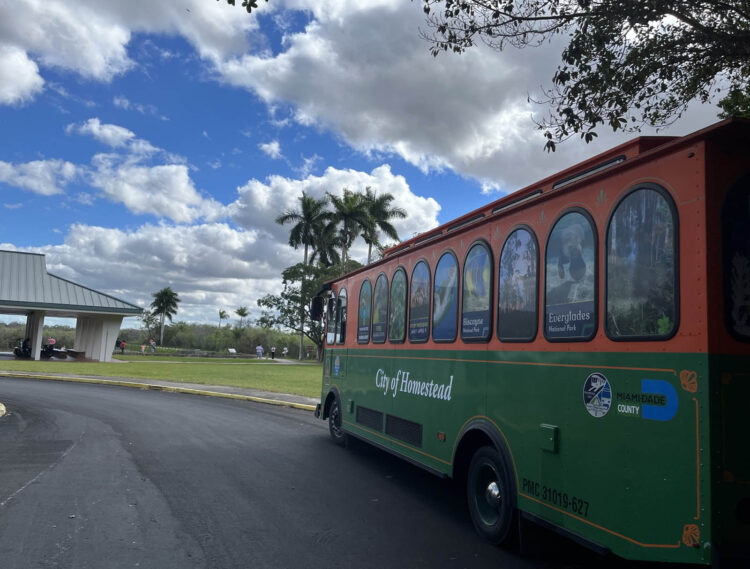
Planning your visit to the Everglades
- Admission to Everglades National Park to $35 per car with a pass good for seven days. As soon as you turn 62, get a senior pass. For $80, it offers lifetime admission to all national parks. Also: Take advantage of these free days in national parks .
- Do not rely on cell phones for critical communication while visiting the park. This is a large wilderness area and most cell phones won’t have service, even along the main roads. AT&T has a tower at Flamingo and service is good for their customers.
- The Everglades National Park website
- Camping in the Everglades
- Everglades National Park map . (Be sure to check for updates and closed areas.)
- The Anhinga Trail
- Shark Valley entrance, with its 15 mile trail and trams ride
- Robert is Here , the funky fruit stand near the Homestead entrance. I consider it an integral part of the “visit the Everglades experience,” and the free trolley does make a 20-minute stop here.
- If you are spending time in the Everglades, the rural area around the Homestead entrance to Everglades National Park is full of interesting places to visit and tasty experiences, including Fruit and Spice Park, Schnebly Redland’s Winery plus strawberry farms and a historic railroad village. This is a guide to visiting the Redland region . This includes the extremely popular Knauss Berry Farm , for strawberry milks shakes and Florida’s best cinnamon rolls, open only fall to spring.
When to visit Everglades National Park? Not summer
There are few places in Florida as inhospitable in summer as Everglades National Park. It is unbearably hot and mosquitos and no see ums are miserable. With water everywhere, the wildlife is not as visible. (The best concentrations of birds require the Everglades to be drying out, which generally occurs later in the winter.)
All the programming in Everglades National Park is built around the winter season, mid-December through Easter. You can have good experiences, however, in the fall — mid- to late-October if you check the weather for good days — and in the spring through the end of April. Both October and April are likely to be in 80s and pretty humid.

Frequently asked questions about Everglades National Park
Can you drive through Everglades National Park?
Yes, at the Homestead entrance to the park, you can drive on the main park road 38 miles from the visitor center to Flamingo. But the best experience in the Everglades will involve getting closer to nature, walking the short trails, kayaking on the waterways or taking a boat tour.
What’s the best time of year to visit the Everglades?
You’ll see the most wildlife when the Everglades dries out mid-winter. When water is less plentiful, wildlife concentrates around the remaining ponds. Depending on rainfall, that can begin in December or January and continue until late spring.
For visitors, the most pleasant weather is December to March. Days in November and April can be pleasant, but they also can hot and humid. June to October are invariably hot, humid and often buggy.
Is it hard to see alligators in the Everglades?
Not at all. The common figure is that the Everglades are home to some 200,000 alligators. Except at the wettest time of year, most visitors will see alligators along the Shark Valley path or the Anhinga Trail in Everglades National Park. But you don’t have to go to the Everglades to see alligators in Florida. Most freshwater rivers and lakes in Florida outside urban areas will have some alligators. They’re also easy to see along the Tamiami Trail in Big Cypress Preserve , adjacent to Everglades National Park. It has no admission price.
Is it dangerous to see alligators in Everglades National Park?
No. One thing that amazes visitors to the Everglades in winter is that you often see alligators right next to or actually on paved pathways and trails. The park advises that you stay 15 feet away from a gator. Alligator attacks are extremely rare, however.
How many days do I need to see the Everglades?
You could spend a lifetime exploring this wilderness. But most visitors will have a day or two.
- If you have only a few hours, visit Shark Valley and take a walk, bike ride or tram tour.
- If you have one day, go to either Shark Valley and also take a drive on Loop Road OR enter at Homestead and explore the stops along the main park road described in the article above.
- If you have two days, start in Homestead and stay overnight in Flamingo, at either the lodge or eco-tents. OR, if it fits your larger itinerary better, go to Shark Valley and stay in Everglades City . On day two, either arrange a kayak trip on the Turner River or take a hike at Fakahatchee Strand Preserve State Park .
More Everglades experiences from Florida Rambler
Big Cypress National Preserve
Florida Rambler guide to campgrounds in the Everglades
Driving across the Everglades on the Tamiami Trail
Driving across the Everglades on Alligator Alley
All articles on FloridaRambler.com are original, produced exclusively for our readers and protected by U.S. Copyright law. Any use or re-publication without written permission is against the law. Read more: floridarambler.com/licensing
This page contains affiliate links from which Florida Rambler may earn a small commission if a purchase is made. This revenue supports our mission to produce quality stories about the authentic Florida destinations at no cost to our readers.

The author, Bonnie Gross, travels with her husband David Blasco, discovering off-the-beaten path places to hike, kayak, bike, swim and explore. Florida Rambler was founded in 2010 by Bonnie and fellow journalist Bob Rountree, two long-time Florida residents who have spent decades exploring the Florida outdoors. Their articles have been published in the Sun Sentinel, the Miami Herald, the Orlando Sentinel, The Guardian and Visit Florida.
This site uses Akismet to reduce spam. Learn how your comment data is processed .
Saturday 16th of September 2023
This is an excellent article — thank you so much! My girlfriend and I are planning to fly to Miami on Christmas Day and staying until either New Year’s Day or the 4th of January, spending most of that time in the park and the rest exploring the Florida Keys and AirBnB-hopping. We like to kayak, bike, and hike. We’re concerned about the lack of kayaking this year due to the redevelopment you mentioned above, but I can’t find much about it when I googled. Can you advise if there will be any/enough kayaking to still spend 4-5 nights at the park? Would you suggest we delay this trip until next year? Just looking for your opinion.
Wednesday 20th of September 2023
@Bonnie Gross, Thanks a million!!!
Bonnie Gross
Maybe I should be clearer in the article. There are three entrances to Everglades National Park and they do not connect -- Homestead, Shark Valley and the Gulf Coast. There are vast wild areas between and around the national park, including Big Cypress National Preserve. The construction is at the Gulf Coast headquarters of Everglales National Park. But there is still excellent kayaking in that area -- my favorite Everglades trip, in fact, the Turner River. https://www.floridarambler.com/kayaking-in-florida/turner-river-kayak-trail-everglades/ It will not be affected by the construction at the Gulf Coast.
Shark Valley is terrific stop, particularly to rent bikes or take the tram. There's no kayaking there, but it is very close to the Turner River, and there are several other kayaking options in the area.
Homestead has several kayaking options, including a few from Flamingo ant the most popular, Nine Mile Pond.
Wednesday 31st of May 2023
Overnight Kayak Camping Tours
Come kayak, explore and truly experience the REAL Everglades! We offer fully outfitted and guided 3-5-8-day overnight kayak camping tours in the backcountry of Everglades National Park. You can find complete details at www.floutdooradventures.com. Feel free to contact me if you have any questions.
Dave K. Florida Outdoor Adventures, Everglades Kayak Tours http://www.floutdooradventures.com [email protected] 386-295-1850
Randy Welch
Tuesday 13th of September 2022
Bonnie - my wife and I have recently retired and have always wanted to visit the Keys and Everglades. I am excited to finally be doing so in October. After reading several of your wonderful articles we are revising our plans to better maximize our sightseeing opportunities. I just wanted to say THANK YOU for for what you do and the wonderful help you are to visitors to the southern Florida area. Now I can't wait to try the Key Lime milkshake at Robert Is Here!!
Randy: Definitely stop at Robert Is Here. Be aware: the Key Lime milk shake is actually pretty tart. My son-in-law got one on a visit with me and he was not a fan. Other flavors are awesome, however. Also: Be prepared for it to still be hot. Fall weather doesn't get her until the end of the month or even November these days. Good luck!
Rachele Kelley
Thursday 24th of March 2022
I wish you could cover the Copeland area of the Everglades. I grew up at fire tower on Jane's Scenic Drive. Do they still have camping?
Rachele A Kelley
Very good info for folks thx
The best times to visit Everglades National Park

Mar 24, 2024 • 5 min read
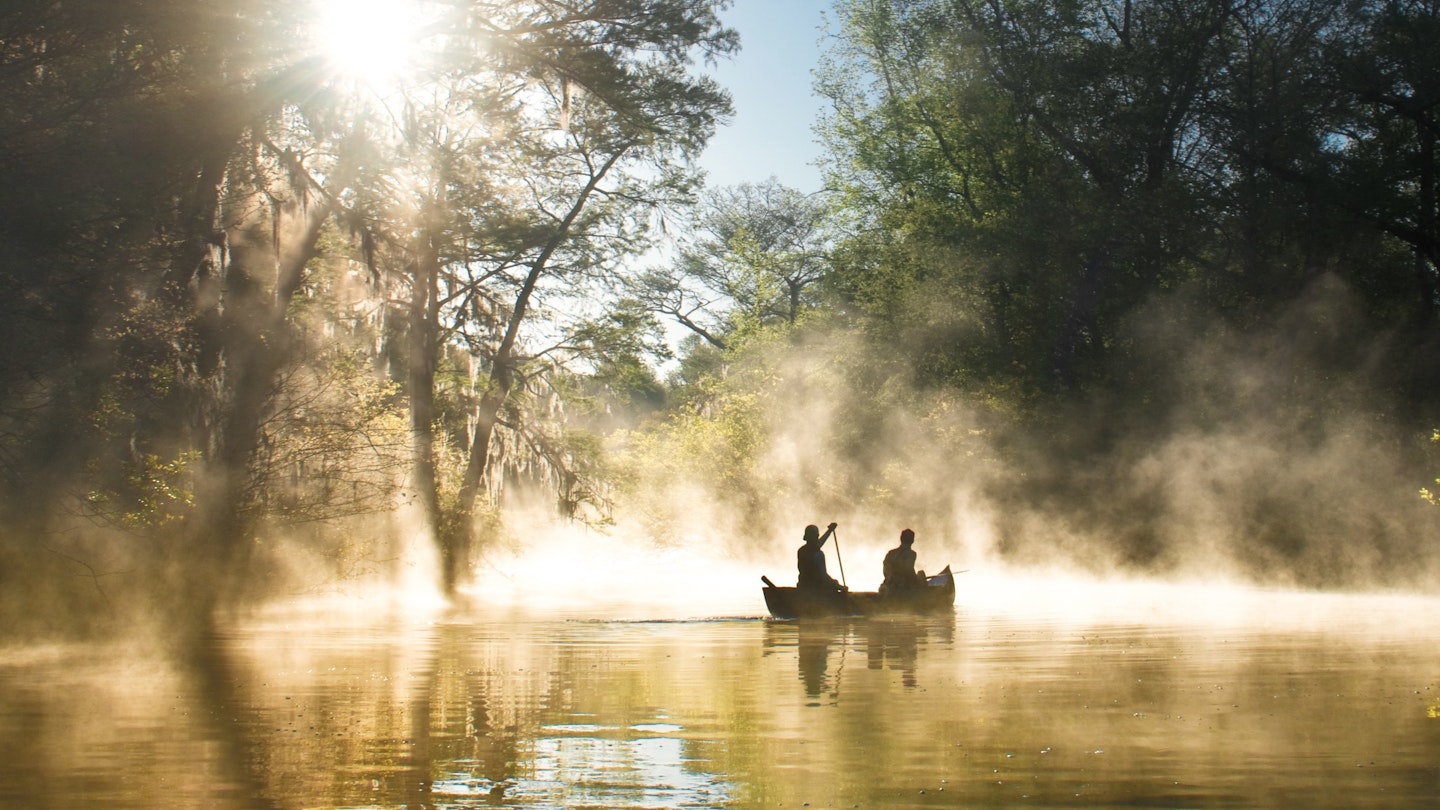
Pick the right time for your visit to Everglades National Park with this seasonal guide © Douglas Rissing / Getty Images
When you decide to go to Everglades National Park can make a world of difference.
While there may be a number of widely recognized “seasons” in Florida – such as snowbird season (October to April), when the Sunshine State is inundated with tourists seeking warmer temps – it’s pretty cut-and-dried within the park itself.
Actually, it’s pretty wet and dry. There are two official seasons at this whopping 1.5-million-acre wetlands preserve: the wet season (May to November) and dry season (December to April). And from crowds and wildlife to mosquitos and the price of activities and lodging outside of the park, you’ll notice the difference.
Plus, as the broader Everglades can be in the eye of hurricanes stemming from the Gulf of Mexico and Atlantic Ocean, there is a time of year when you’ll need to stay vigilant while exploring the largest subtropical wilderness in the US. As you balance the elements, these are the best times of year to visit Everglades National Park.
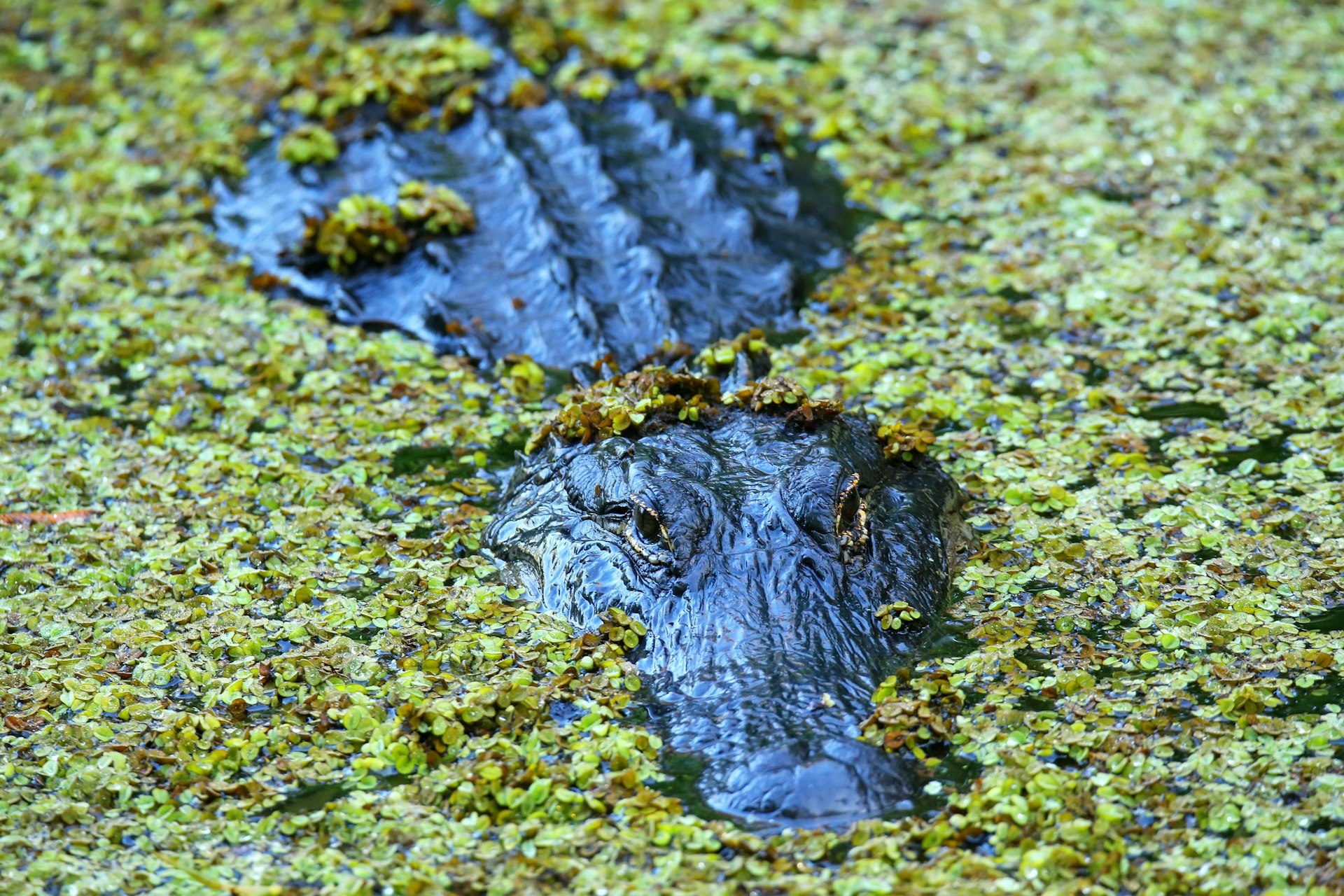
Dodge the mosquitos and heat during the dry season in December to April
The dry season is the prime time to visit Everglades National Park. On the wildlife front, less rain makes for smaller pools of water for some of the Everglades' most beloved critters – crocodiles, alligators and wading birds among them – to take a dip. This means the animals are less submerged, often found plopped in the water or waiting nearby for a chance to splash. Less standing water also means fewer mosquitos, which are particularly aggressive and pesky during the park’s wet season.
Climate-wise, thunderstorms are scarce, and you can count on highs pleasantly above 70°F (21°C) with lows dipping below 60°F (15.5°C) on some nights. All of the elements make for pleasant camping conditions at the likes of frontcountry options such as Long Pine Key Campground and Flamingo Campground . Just make sure to reserve weeks, if not months, in advance.
Crowds are larger during this time frame compared to others, particularly along visitor favorites like the Shark Valley bike and tram trail or gator-draped Anhinga Trail near the park’s Homestead entrance. Arrive as early as possible where you can; for Shark Valley, the area opens at 8:30am and the Homestead entrance is open 24 hours a day.
For ranger-led tours, the dry season is the time to experience the full spectrum of programming at Everglades National Park. For example, from December through March, a popular option is the bike hike from the Ernest F Coe Visitors Center in Homestead, during which a ranger guides folks into the wetlands where gators and white ibis often abound. The tour includes helmets, water and yes, a bicycle.
Be ready for your trip with these 12 things to know before visiting Everglades National Park
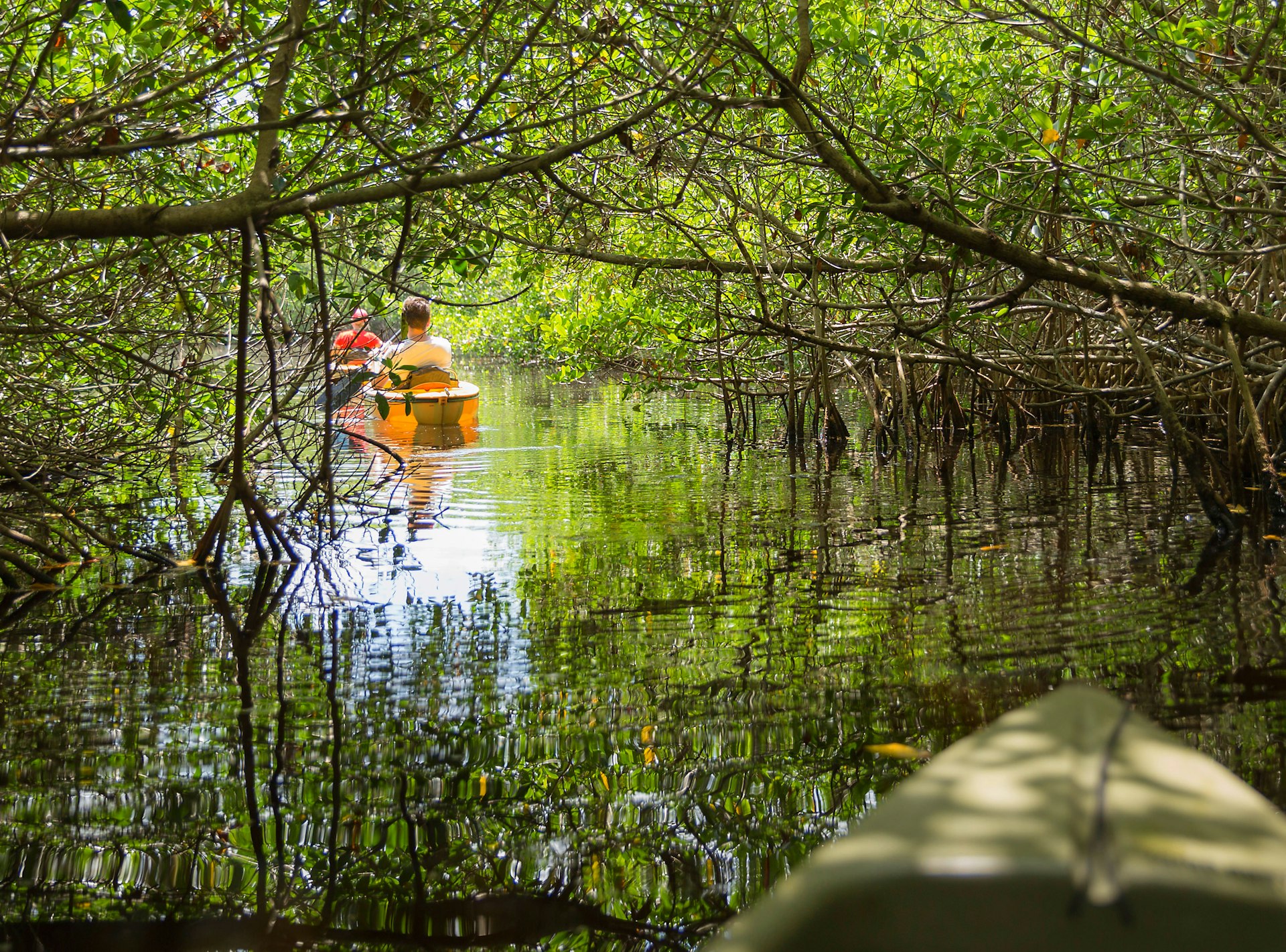
May through August is wet season and the best time to beat the crowds
May officially kicks off the wet season in Everglades National Park, but it’s not super-wet just yet, averaging six days of rain (which, much like the rest of South Florida , can equate to a light afternoon thunderstorm for approximately 30 minutes). Temperatures generally remain pleasant too, with highs of around 85°F (29°C), so if you’re looking for that happy medium between smaller crowds and livable temps, May is arguably the best month.
The heat and humidity turn up in the June-through-August stretch, making for a very muggy and swampy experience. If you are accustomed to a drier climate, prepare for a nonstop sweat-fest, with high temperatures around 90°F to 95°F (32°C to 35°C) and daily thunderstorms.
With the mugginess, crowds are much more sparse than during the dry season. Do keep an eye on ranger-led programming, like starlight walks along the Anhinga Trail or tours of the Nike Missile Site , as the bulk of the official tours are only available during the dry season.
There are other perks to visiting during this time. The rains bring a fuller, lusher vibe to the Everglades landscape – the greenery and flora pop. This is the season to see a hearty selection of the park’s nearly 40 orchid species come to life, as well as the native bromeliads, which mimic a mix of a pineapple and Spanish moss. With the waterways more full, this is also the season for additional kayaking and paddling options , like the Sandfly Island Loop and Turner River near Everglades City.
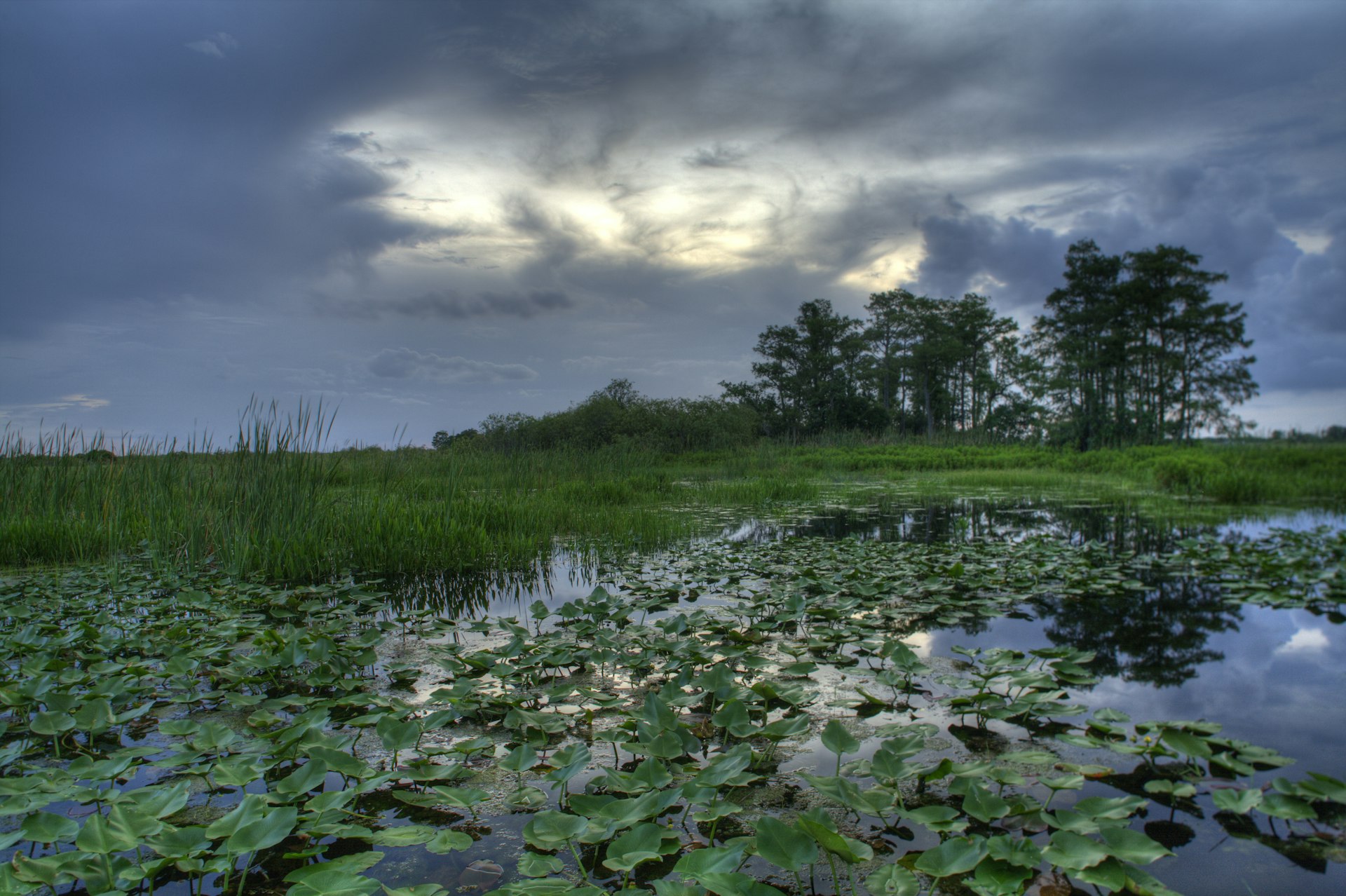
Get good deals in September through November, but hurricanes are a risk
High temperatures begin to inch back down in September, with the mercury typically above 85°F (29°C), reaching 80 to 82°F (26 to 28°C) by November. The humidity equally subsides.
Whereas the everyday climate is much more pleasant than the core of summer, there are hurricanes to monitor. The Atlantic hurricane season is officially June through November, with September being the peak month for activity throughout South Florida, the Caribbean and adjacent regions. So if you’ve booked a trip months – or even days, really – in advance, a last-second storm could interfere.
With this weather-driven risk, the broader South Florida region is typically less full of tourists, and you can snag attractive deals nearby. So for hotel deals in Miami , Fort Lauderdale , West Palm Beach , the Florida Keys and Naples before the influx of snowbirds, this is the time.
Keep planning your trip to Everglades National Park:
Add these experiences to your itinerary Get up close with nature on these hikes Take a road trip to the park on these drives through Florida Know these things before you go
This article was first published Feb 7, 2023 and updated Mar 24, 2024.
Explore related stories
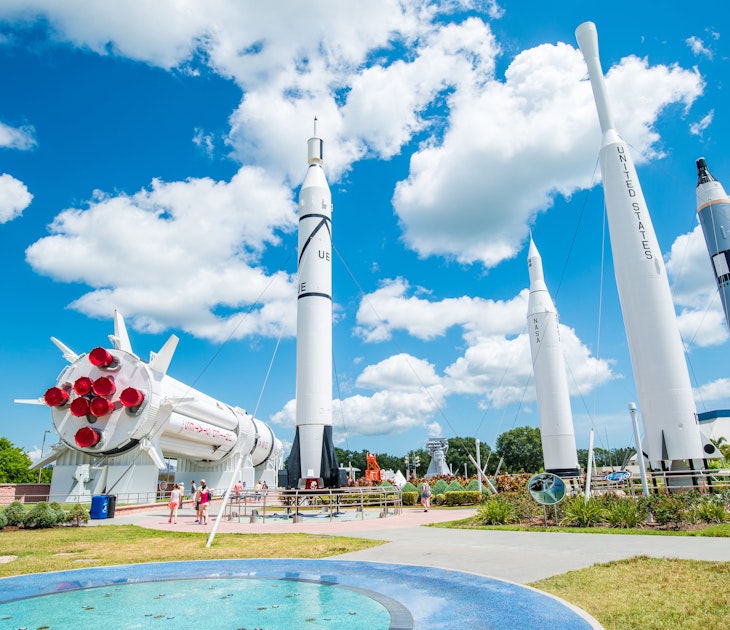
Destination Practicalities
May 5, 2024 • 7 min read
You came to Orlando for the theme parks, but this dynamic city gives you plenty of reasons to stay.

Apr 19, 2024 • 10 min read
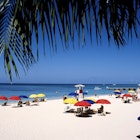
Apr 18, 2024 • 10 min read

Apr 17, 2024 • 8 min read

Apr 15, 2024 • 10 min read

Apr 14, 2024 • 6 min read

Apr 12, 2024 • 5 min read
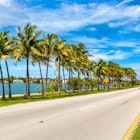
Apr 10, 2024 • 6 min read
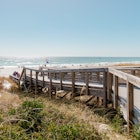
Apr 8, 2024 • 7 min read

Apr 8, 2024 • 6 min read
Florida Travel Blog
Travel destinations, beaches and attractions and things to do in Florida. Documented by RESIDENTS of Florida.
100 Extraordinary Facts About the Florida Everglades
Extraordinary fun facts everglades.
It is relatively easy to find extraordinary fun facts about the Florida Everglades . This one-of-a-kind ecosystem cannot be duplicated anywhere else in the world. The value to Floridians cannot be overstated.
As early as the late 1800s we began to understand the ecological significance of “The River of Grass”, the Everglades. An author by the name of Marjory Stoneman Douglas released her first book titled The Everglades: River of Grass . The title caught on and so did our awareness of this wild, wonderful back country.
Our fun facts about the Everglades hope to capture this 8th Wonder of the World in all its untouched glory. These Everglades facts below will hopefully be a conduit for more people to learn, visit and enjoy the Everglades like we do.

10 Most Astonishing Facts About the Everglades
- The Everglades is the only place in the world where alligators and crocodiles coexist!
- The Everglades is the largest wetlands in the world.
- Water moves constantly through The Everglades – generally from north to south.
- 39 rare species inhabit the Everglades that are listed as extinct or almost extinct in the world.
- 33 species of mosquitoes inhabit the Everglades – 13 of which bite people!
- The Everglades is the largest wilderness in the Eastern United States.
- The Everglades is the only subtropical preserve in the Northern Hemisphere.
- Everglades National Park covers 1,508,000 acres of The Everglades.
- The elevation of the Everglades is mainly at 0 feet, but does rise to 8 feet in a couple of places. However, there is a shell mound, created by the Calusa Indians, of over 20 feet on the Gulf Coast.
- One-third of Florida’s population depends on the Everglades for drinking water.
Map of the Florida Everglades

The green area of the map of the Everglades shows the extent of runoff of three rivers from central Florida.
Any and all of these lands are affected by what we call the Everglades. The underlying water moves at a pace of one-half mile per hour.
The significance of the aquifer surrounding these wetlands cannot be underestimated. The water gives life to the plants, trees, and wildlife for 100 miles south.
Can you drive through the Everglades?
You can drive through the Everglades in a number of ways. If you look at the map, you will see two main routes running east and west through much of the Florida Everglades. These are the quickest ways to cross the Florida Everglades, but not necessarily the best way.
Route 41 and The Tamiami Trail through the Everglades
By far, our favorite way to drive through the Florida Everglades is the Tamiami Trail . Of course, Interstate 75 from Naples to Miami (named Alligator Alley) can take you across the Everglades quicker, but do you really want to miss all the sights in this biodiverse wetland?
Our comparison of The Alligator Alley vs. Tamiami Trail can explain the differences and add some fun facts about the Everglades.
How Big Are The Florida Everglades?

The easy answer is the Everglades covers several million acres in south Florida. However, this answer simplifies the breadth and scope of the “River of Grass”.
The Everglades actually start from the run-off of three rivers in central Florida. These rivers flow into Lake Okeechobee and eventually through the grasslands to form an ecosystem that empties into Florida Bay along the southernmost part of Florida.
To put a number on the question “How Big are the Florida Everglades”, the current thinking is the Everglades are about 40 miles wide and 100 miles long encompassing more than 2.5 million acres. For more details, this government publication may be helpful.

Everglades National Park Facts
We tend to use the term Everglades referring to a large area in south Florida with swamps, towns, islands and Indian reservations. There is no definitive boundary, line of demarkation or specific start and finish.
While all of the above is correct, that definition also includes what is the largest national park in the country called Everglades National Park . The Everglades National Park is a defined area with over 1,5 million acres.
There are 5 visitor centers scattered throughout the Everglades. Each is designed to cover a portion of the wilderness and offer assistance to visitors.
The visitor centers are:
The Gulf Coast Visitors Center , in Everglades City .
Shark Valley Visitor Center , along the Tamiami Trail .
Ernest F. Coe Visitor Center , Homestead, Florida
Royal Palm Visitor Center , on Rt. 9336 on road to Flamingo.
Flamingo Visitor Center , Flamingo, Florida deep in the Everglades.
If you visit all of these visitor centers, you will have seen much of the Everglades. In fact you will see many sights like the picture below!

How to avoid alligators in the Everglades?
The quick answer is to stay away from their habitat. Marshes, swamps, banks of sloughs, river banks, and freshwater lakes in the Everglades all have alligators.
However, most people want to see alligators. They are rarely harmful to adults unless surprised or defending their offspring.
Alligators can easily be seen from roadways and parks along the major highways in the Everglades. Worry more about the “ swamp angels ” than the alligators in the Florida Everglades. There are many places designed to see alligators in Everglades National Park.
Are there crocodiles in the Florida Everglades?
Yes, there are crocodiles in the Florida Everglades. Crocodiles prefer saltwater , so most sightings come from southern portions of Florida near Florida Bay. Their numbers are very small.
One of the cool facts about the Everglades is it is the only place in the world where crocodiles and alligators coexist. This is one of the best extraordinary fun facts about the Florida Everglades National Park.
Are there panthers in the Everglades?

Yes, there is the Florida Panther . The Florida panther is a sub-species of the western puma which is one of the little known facts about the Everglades. Unfortunately, the Florida panther is an endangered animal which is one of the bad Everglades facts. Current estimates suggest there are less than 500 panthers left in the wild.
If you are fortunate enough to spot a panther, you have done something that millions of visitors to the Florida Everglades have never done.
Are there pythons in the Everglades in Florida?
By now most people have heard about the Burmese pythons roaming the deep Everglades.
While it is true, the chances of encountering a python are very remote. There are no known deaths from python attacks on visitors to the Everglades. A python can bite and leave some soreness, but they are not poisonous. Everglades fact, it would be unusual for a visitor to see a python.
The python is an evasive species that is very harmful to the Everglades. They grow to 16 feet or more and feed on small animals. rabbits, raccoons, and opossums are disappearing. Florida has put a bounty on Everglades pythons .
What is Everglades National Park?

The Everglades National Park is the largest tropical wilderness in the United States. The park has over 1.5 million acres in three different counties (Dade, Monroe, Collier) on Florida’s southern Gulf coast. The park offers the best experience for learning, observing, and photographing this wonderful preserve.
One of the many Everglades National Park facts is the park was created in 1934 and is the largest mangrove ecosystem in the western hemisphere.
What animals are in the Everglades?
There are over 120 species of animals in the Everglades. Plus about 300 species of fish. In addition, there are countless numbers of insects.
Wild boar, black bears, otters, turtles, deer, and various snakes populate the Everglades along with the ones previously mentioned.
One of the cool Everglades facts is that more species of animals live there than anywhere else on earth.
What plants are in the Florida Everglades?
One of the wonders of this ecosystem called the Everglades are the varieties of plant life. There are literally hundreds of different types of plants throughout the Everglades. Many only exist in the Everglades in the northern hemisphere.

What birds are in the Everglades?
The National Audubon Society says there are over 400 species of birds in the Everglades. Our experience seems to indicate that to easily be true. It seems every trip we see another bird we have never seen before. There are over 360 species sighted in the Everglades National Park alone.
Do people live in the Florida Everglades?
It is pretty clear people have lived in the Everglades for thousands of years. They were Native Americans, Spanish explorers, runaway slaves, and traders who made the Everglades home. Everglades facts tend to suggest the populations were small and scattered mainly near freshwater sources.
Life in the Everglades was and is harsh. The heat wants to exhaust you. Animals want to make you prey. Insects want to feed on you and the swamps want to devour you.
Despite the hardships, the Everglades were perfect for hunters, fishermen and woodsmen . Man seems to find a way to overcome challenges.
Today, Everglades City and Chokoloskee are examples of communities that have found ways to live in the ’glades .

Scattered in other parts of the Everglades are remnants of the Seminole and Miccosukee tribes. Everglades facts shows their ancestors escaped to the Everglades from persecution and relocation. Villages dot the backroads of the Everglades. These Native Americans found safety in the torrid conditions of the wilderness.
When, in the 1840s, soldiers tried to find the escapees from relocation in the Everglades, one surgeon attached to a brigade wrote this description of the Everglades, “It is in fact a most hideous region to live in, a perfect paradise for Indians, alligators, serpents, frogs, and every other kind of loathsome reptile.”
Of all the extraordinary fun facts about the Florida Everglades, the harshness of life hasn’t changed much. The weather, animals, water, and extreme conditions are still a challenge to residents.
Where is Everglades City?

Everglades City is about 35 miles southeast of Naples, Florida. The only road in or out of Everglades City is state route 29 which runs north to south crossing the Tamiami Trail about 30 miles east of Naples.
Many residents of Everglades City are engaged in, or supporting the fishing and crabbing industry. The town produces a significant amount of stone crabs served to Florida residents.
While there have been some important renovations around Everglades City in recent years, the area has struggled to grow in the Everglades environment. The population has varied little in the last 50 years.
Among the various facts about the Everglades is that more stone crabs come from this area than anywhere else in the state.
Are there Sharks in the Everglades?
Since part of the Everglades includes places like Ten Thousand Islands, Flamingo and Everglades City, we can assure you there are sharks in the Everglades.
You may wonder how many types of sharks are there in Florida ? The fact is there are at least 30 different types and potentially many more that have been undetected.
That doesn’t mean all 30 types will be in the Everglades. Most likely the list includes –
- bonnethead,
- hammerhead,
- tiger sharks
you may see around the Everglades.
Why are the Everglades so important?
One key reason the Everglades are so important is the ecosystem is the source of water for 8 million Florida residents. That is, one in every three people in Florida depends on the Everglades daily.
Another reason the Everglades are important is the wilderness, bays, and rivers provide a breeding ground for thousands of species of fish, mammals and birds. Without the couple million acres of protection, our environment and food supply would suffer.
Man has built up many areas in south Florida. Without the benefit of the Everglades’ drainage, many cities, towns, and farms would be flooded each year during the rainy season.
If for no other reason, the Everglades is one of the most unique wilderness destinations in the world. The beauty and sustenance system of life abound in the Everglades.

What are things to do in the Everglades?

Our list of popular things to do in the Florida Everglades.
- Perhaps the most popular of the things to do in the Everglades is an airboat tour. Numerous operators offer tours along both Alligator Alley and the Tamiami Trail. Different experiences are offered including alligator watching and full-speed runs through the mangroves and grass flats.
Most airboat companies explain the history and importance of the Everglades ecosystem.
- Many people visiting the Everglades are fascinated with alligators. They go to the various rest areas along the major roads to watch, photograph and study these prehistoric creatures. This guide to Alligator Alley will give you the rest area locations. The Tamiami Trail also has some state-built areas that attract alligators.

- Clyde Butcher Galleries – Clyde is the foremost known artist of the Everglades. His gallery is a perfect place to view his amazing work. The gallery also has a boardwalk extending into the Everglades for viewing the sights and sounds of the swampy wetlands.
- Skunk Ape Headquarters – yes, there are reported sightings of an ape-like creature that has the smell of a skunk. Visit this Everglades novelty.
- The Smallest Post Office – there aren’t many people living in the Everglades and need for mail is limited. The USPS has a post office about the size of a double-wide phone booth. Great for pictures.
- Wooten’s Airboat Tours – Wooten’s is our favorite airboat tour operator. This family-owned company has been in the Everglades for generations.
- Hiking The Everglades – there are many hiking trails and a few boardwalks extending well into the swampy wilderness. This growing trend is perfect to see how the Everglades have evolved by hiking through the trails.
- Camping in the Everglades – There aren’t many hotel rooms in the Everglades, but there are numerous places to camp. Camping is available in Everglades National Park , Big Cypress Preserve and all the way south to Flamingo at the tip of mainland Florida. Research your preferences for camping and don’t assume availability.
Get Your Guide to Things To Do in the Everglades
Want to visit a real swamp in the Florida Everglades?

There is a special road in the Everglades that you can travel to visit a real swamp in the Everglades. Near mile marker 59 on the Tamiami Trail (route 41) is an intersection of a poorly marked road called Loop Road. This 25 mile stretch of mainly gravel and dust takes you through some of the off the beaten path terrain offered in this diverse, wonderful ecosystem.
A word of caution is explained in our complete narrative about Loop Road . You can visit the harshness of the swamp with leaving your car. Alligators may cross your path, birds of prey wait in the trees, the swamp on both sides of the road is filled with life and fish you may never have seen before swimming in the sloughs.

Near the eastern reaches of Loop Road are the residences of Native Americans who still live in the Everglades. A few scattered homes of other Everglades inhabitants are on either side of the road.
Fishing the Florida Everglades
We are asked about fishing in the Florida Everglades on occasion. Answering that question is very difficult due to the diversity of the water.
On the Gulf coast, you have the Ten Thousand Islands that run for miles along the southwest Florida shoreline. Here you have saltwater and a brackish mixture of saltwater and freshwater.

Fishing in the Ten Thousand Islands is phenomenal. Our excursions have produced spotted trout, redfish, tarpon, snook, and an occasional shark feeding at the rivers’ mouths. The numbers of fish and size are exceptional. Chartering a local fishing captain from Marco Island, Everglades City or Chokoloskee is the best way to fish the islands.
In South Florida, there is Florida Bay stretching from Florida City to the bend at the southern end of the Ten Thousand Islands. This remote fishing is a fantastic adventure that includes the species above but also includes many fish considered to be “offshore species” that spawn in the shallower water of Florida Bay. The fishing is as diverse as it gets in Florida.
We can’t forget the freshwater species in the lakes formed in the interior of the Everglades. Everything from bluegill, specs, bass and other unique fish of the Everglades are available. Again, we recommend a guide to assure success for the visiting fisherman.
Where to stay in the Florida Everglades?
The places to stay are very few in the Everglades. While there are a couple of hotels and motels in Everglades City , there aren’t many other choices within the boundaries of the Everglades.
Where to stay near the Everglades in Florida?
There are metropolitan areas at both the eastern and western extremes of the Everglades. Our general recommendation is to stay on the western side due to the proximity of other attractions in the Everglades. We would suggest Naples and Marco Island as places with a wide range of choices for accommodations of all sizes and budgets. Miami on the eastern extreme is also an option.
Extraordinary Fun Facts About the Florida Everglades Additional Information
The extraordinary fun facts about the Florida Everglades are presented here to help the understanding and importance of this diverse ecosystem.
F lorida Travel Blog knows the historical significance and gravity of our future if development conquers good judgment in preserving the Everglades.
Below are more resources and fun facts about the Everglades.
For Other Facts About the Everglades
A Captivating Journey Through the Everglades
The Origins of the Florida Everglades by USF
History and Culture of the Everglades
Restoring the Everglades

More from Florida Travel Blog

Best Beachfront Hotels on Florida Gulf Coast in 2024

Navigating the Crown Jewels of Florida: What Are The Names of the Florida Keys?

10 Best Family Resorts in Florida

10 Romantic Getaways for Couples in Florida
Book your entire trip with one of these money saving partners!

Florida Travel Blog is an Amazon Associate, we may earn a very small commission from qualifying purchases. or other affiliate links. Your cost is not affected.
REGIONS SEARCH
The best of florida travel blog.

Indulging in Nature’s Wonders: Discovering Florida’s National Parks and Wildlife Sanctuaries

Exploring the Greek Culture: Top 25 Things to Do in Tarpon Springs

Tarpon Springs Beaches – Looking for Hidden Gems on Florida’s Gulf Coast

From Ancient Seas to Modern Streets: Discover Tarpon Springs Florida Greek Heritage

Tempting 20 Day Trips From Sarasota Florida

Find a Destination
Florida Travel Blog is a participant in the Amazon Services LLC Associates Program and other similar arrangements. These are affiliate advertising programs designed to provide a means for sites to earn advertising fees by advertising and linking to amazon.com. These small commissions do not increase the cost to the consumer.

About Florida Travel Blog – Sign Up For Our Newsletter – Contact Us – Florida Road Trips – Florida History – Florida Recipes – Florida Day Trips – Orlando Vacation

Join our Mailing list!
Get all our latest posts and our monthly Florida Travel Newsletter with the latest posts and Florida Travel News.
Your browser is not supported for this experience. We recommend using Chrome, Firefox, Edge, or Safari.
Find Your Favorite Beach

Atlantic Coast

Beach Camping

Family-Friendly
Places to stay.

- Campgrounds

Travel Ideas

Accessible Travel

Eco-Friendly Travel

African American Heritage Travel
More Travel Ideas
Popular links.

Florida Webcams

Toll Roads Info

Travel Guides
Everglades city.
Everglades City , 36 miles south of Naples on Florida’s Southwest Coast , is a small community where visitors can truly get away from it all and the perfect staging point for a family-friendly Everglades vacation or Gulf-Coast fishing getaway.
The charming waterfront city’s proximity to Everglades parks and wild Gulf islands make it an outdoor adventurer’s paradise. Fish Ten Thousand Islands , kayak the Paradise Coast Blueway , check out the Gulf Coast Visitor Center at Everglades National Park , and choose from a host of companies offering excursions to the Everglades, fishing charters, airboat tours, swamp buggy tours, and eco-tours. Some of Florida’s most iconic preserves and parks, including Big Cypress National Preserve , Florida Panther National Wildlife Refuge , Picayune Strand State Forest , and Collier-Seminole State Park , are all within easy reach of Everglades City.
Culinary offerings here range from fresh-from-the-water seafood to cafe fare and Cuban-American cuisine. Everglades City is known as the “ Stone Crab Capital of the World,” and visitors can get this delicacy at local eateries and fish sellers during stone crab season, which runs from Oct. 15 until May 1. The 100-year-old Everglades Rod & Gun Club is a historic local gem where visitors can eat in the same club where several presidents have dined, stay at the resort , and dock at the marina .
Ochopee, a 10-minute drive from Everglades City, is where visitors can find Clyde Butcher’s Big Cypress Gallery and see the famous black-and-white works of Florida’s best-known photographer. Quirky, family-friendly attractions, including the The smallest post office in the U.S. and Skunk Ape Research Headquarters , are also nearby. The Smallwood Store , four miles from Everglades City on Chokoloskee Island , is full of Florida pioneer history and rumored to be haunted.
Plan your trip to the Paradise Coast .
Explore the parks, spot dolphins on an eco-tour, the area’s family-friendly attractions.
- Skunk Ape Research Headquarters
- More kid-friendly experiences
MUSEUMS, ARTS & ENTERTAINMENT
Visit the museum and local attractions.
- Museum of the Everglades
- Big Cypress Gallery
- Attractions
OUTDOOR ADVENTURES
Book a fishing charter, airboat tour, or swamp buggy tour, and explore the area’s many parks and preserves.
- Gulf Coast paddling trails
- Ten Thousand Islands National Wildlife Refuge
- Big Cypress National Preserve
- Florida Panther National Wildlife Refuge
- Picayune Strand State Forest
- Collier-Seminole State Park
- Everglades National Park
- Wellness retreats and eco-tours
- Airboat tours
- Fishing, charters, and more
Take a drive to visit the beaches of Naples and Marco Island.
- Naples and Marco Island beaches
ACCESSIBILITY
Visit the area’s accessible attractions.
- Everglades National Park accessibility information
- Everglades City Boardwalk
Enjoy fresh seafood, Cuban-American cuisine, and more.
- Taverns and grills
Pick up essential supplies, gifts, and seafood to go.
- Glades Haven General Store
- Historic Smallwood Store
- Grimm’s Stone Crab, Inc.
- More places to shop
PLACES TO STAY
Book a stay at a hotel, motel, fishing lodge, resort, or campground.
- Hotels and motels
- Vacation rentals
Exploring Florida's 10,000 Islands
Quick facts.
Best access to old Florida swamp life.
Nearest Airport
- Everglades Air Park
- Marco Island Executive Airport
EVERGLADES CITY BUSINESS LISTINGS
Nearby cities, marco island, chokoloskee, related content, everglades city: eco-tours, kayaking, fishing & fun.
- 3 minute read
Unique Florida vacations have been on my radar lately, so we recently packed up the van and took the boys to Everglades City. If you’ve never...
Discover Old Florida at the Rod & Gun Club in Everglades City
- 5 minute read
By Steve Winston There’s a place on the Southwest Coast of Florida, deep in the 10,000 Islands area of the Everglades, where it’s still...
STRATEGIC ALLIANCE PARTNERS
- Search Please fill out this field.
- Manage Your Subscription
- Give a Gift Subscription
- Newsletters
- Sweepstakes
- Human Interest
Florida Man Who Fell into Shark-Filled Marina Says He 'Got Very Lucky': You 'Don't Feel the Teeth Going In'
Marlin Deere Wakeman of Stuart, Florida, was working on a boat in the Bahamas when he slipped into a marina
Gabrielle Rockson is a staff writer-reporter for PEOPLE. She joined PEOPLE in 2023 and covers entertainment and human interest stories. She's interviewed David Beckham, Zendaya, Timothée Chalamet and many others. Her previous work can be found in OK! Magazine, MyLondon, GRM Daily, and more.
:max_bytes(150000):strip_icc():format(webp)/Biopicture-7aed89e79c07468e879a00bb6ff007dc.jpg)
A Florida man named Marlin Deere Wakeman is opening up about how lucky he is after falling into a marina filled with sharks.
According to ABC News , the 24-year-old from Stuart was working on a boat in the Bahamas when he slipped into the Flying Fish Marina, where the boat was docked. NBC News reports that the incident took place on April 26.
“When I got bit, I was pulling myself back in and he grabbed my leg, the first shark did, and pulled me underwater,” Wakeman said at a press conference, per WPTV . “Kind of scrambled for a second, [then] I got my surroundings in check and realized what was going on.”
He added that although he was able to grab the boat with his left hand, another shark “came and hit me on my right side, my right shoulder.”
Never miss a story — sign up for PEOPLE's free daily newsletter to stay up-to-date on the best of what PEOPLE has to offer, from juicy celebrity news to compelling human-interest stories.
Despite the second shark arriving at the scene, the man was able to pull himself back into the boat and call for help.
Speaking of the first shark’s bite, Wakeman said, per NBC News, "I got really lucky he didn’t head shake or hold on for a while.”
"And then that’s when I was able to get back up to the surface,” he continued, adding of the second shark, “The one on my shoulder felt like a punch. ... You really don’t feel the teeth going in .”
His captain, who was nearby, quickly came to Wakeman’s assistance. Per ABC News, the captain tied Wakeman’s leg with a tourniquet after he got out of the water.
Wakeman recalled that after the adrenaline wore off, he began to feel a lot of pain, telling his captain, “ 'Hey man, like, I really don't want to die right now. Like, this ain't it.' "
According to Dr. Robert Borrego, per the outlet, Wakeman was then taken to St. Mary's Medical Center for surgery in West Palm Beach, Florida.
Speaking of the marina he fell into, Wakeman told reporters, “So that marina in particular, out of all the marinas I’ve been to in my entire life of working on boats, that exact marina is the worst marina I’ve ever seen.”
“There is at all times 20 sharks roaming around,” he said, adding that he and his friends had always spoken about how “you are done” if one of them fell into the marina.
"I have several friends who have been bitten and it’s a shocking revelation when you see that," Wakeman’s father Rufus Wakeman said, per NBC News. "Some of the wounds these people have had to endure . And now it’s my son. It’s our son. And it’s just scary."
PEOPLE has contacted the Flying Fish Marina for comment.
Related Articles
- Skip to global NPS navigation
- Skip to this park navigation
- Skip to the main content
- Skip to this park information section
- Skip to the footer section

Exiting nps.gov
Alerts in effect, basic information.
Last updated: April 25, 2024
Park footer
Contact info, mailing address:.
40001 State Road 9336 Homestead, FL 33034-6733
305 242-7700
Stay Connected

IMAGES
COMMENTS
Mailing Address: 40001 State Road 9336. Homestead, FL 33034-6733. Plan your visit to Everglades National Park, Visit Everglades National Park, Visit Everglades, everglades tours.
There are many ways to experience the Florida Everglades National Park - here are nine entry points. Corkscrew Swamp: Land of Giants. Deep in the heart of Corkscrew Swamp Sanctuary, in the largest stand of old-growth cypress trees on the planet, living giants tower over the primeval landscape. Some of the trees measure more than 135 in height ...
Established: December 6, 1947. Size: 1,542,526 acres. Annual visitors: 1 million. Visitors centers: Everglades has four: Ernest F. Coe near Miami, Guy Bradley in Flamingo, Gulf Coast in Everglades ...
America's Everglades - The largest subtropical wilderness in the United States. Everglades National Park protects an unparalleled landscape that provides important habitat for numerous rare and endangered species like the manatee, American crocodile, and the elusive Florida panther. An international treasure as well - a World Heritage Site ...
Around an hour's drive from Miami on Florida's southern tip, Everglades National Park offers 1.5 million acres of natural wonder. Covering an area the size of Rhode Island, this complex and vital ecosystem of wetlands, swamps, mangroves and forests is North America's biggest protected sub-tropical wilderness reserve.. Teeming with wildlife such as alligators, crocodiles, manatees and birds ...
Learn about where to see birds in the park, why Everglades restoration is important for the park's birds, and more. Wildlife. ... Visit nearby south Florida parks. Last updated: March 21, 2024. Park footer. Contact Info. Mailing Address: 40001 State Road 9336 Homestead, FL 33034-6733 Phone: 305 242-7700.
6. Tour the Ten Thousand Islands via boat. Since Everglades National Park consists primarily of swamps, lakes and marshes, you'll need a boat to get around. For a true open-water experience, head to the Gulf Coast Visitor Center to catch a 90-minute, ranger-narrated boat tour through Florida Bay aboard a large catamaran.
Visit Florida Take an airboat tour. There are three airboat companies that operate in the park, and Gantt says cruising through the Everglades on a flat-bottomed boat is a must during your visit.
There's a spectacularly adventurous yet oddly soothing way to experience Southwest Florida - the Everglades. For the adventure-minded outdoor enthusiast, the Everglades is a paradise of adrenaline, and at the same time, a place to reconnect with your inner self and experience quiet solitude. What many people don't realize before heading ...
Address. Florida, USA. Phone +1 305-242-7700. Web Visit website. Everglades National Park, the third-largest national park in the U.S., is a vast, diverse and fascinating wilderness area that takes up most of the bottom tip of the Florida peninsula. The 1.5 million acres of wetlands are filled with millions of alligators, turtles, wading birds ...
THE FLORIDA EVERGLADES It's an ecosystem found nowhere else on the planet. The Florida Everglades is indeed a world of its own, full of wildlife, history, adventure, and tranquility. ... VISIT FLORIDA® is a service mark of the Florida Tourism Industry Marketing Corporation, d/b/a VISIT FLORIDA, registered in the U.S. Patent & Trademark Office ...
Welcome to the Everglades - Keep Your Eyes and Ears Open. I'm one of those Everglades boys who can't get enough of swamps, alligators and interesting characters, who don't mind slapping mosquitoes or skinny-dipping where there may be snakes. My passion for the Florida Everglades started when I began bass fishing with my dad as a kid.
Anhinga Trail. For most visitors, the Anhinga Trail is one of the first glimpses they'll get of the Everglades National Park. Very close to the Royal Palm Visitor Center, the Anhinga Trail is one of the Everglades' best attractions. Just short of a mile, the Anhinga Trail is one of the most accessible in the Everglades, even for novice hikers.
The Everglades' Flamingo Visitor Center is located on Florida Bay, 38 miles south of the Ernest Coe Visitor Center. From late November through April, this section of the park buzzes with water ...
The Anhinga Trail: Your 'must do' in Everglades National Park. Four miles after entering the park you come to the one "must do" of the Everglades visit — the Anhinga Trail at Royal Palm. This is most reliable place to see alligators and Everglades wading birds surprisingly close within the Everglades.
May through August is wet season and the best time to beat the crowds. May officially kicks off the wet season in Everglades National Park, but it's not super-wet just yet, averaging six days of rain (which, much like the rest of South Florida, can equate to a light afternoon thunderstorm for approximately 30 minutes).Temperatures generally remain pleasant too, with highs of around 85°F (29 ...
At Shark Valley you can walk, bike, or ride a tram along a 15-mile loop road and see some of the park's best wildlife concentrations. The Shark Valley observation tower offers a 360 degree view of the Everglades. The viewing deck overlooks a life-filled water hole, providing a bird's eye view of alligators, turtles, fish, and birds.
1-Hour Air boat Ride and Nature Walk with Naturalist in Everglades National Park. 351. Airboat Tours. from. C$238. per adult. Miami Combo: City Tour, Biscayne Bay Cruise and Everglades Airboat Ride. 301. Full-day Tours.
The park has multiple entrances and visitor centers including Ernest Coe Visitor Center , Flamingo Visitor Center , Shark Valley Visitor Center , Gulf Coast Visitor Center. They are all open 365 days a year. For more information, visit the National Park Service Everglades National Park website or call 305-242-7700.
Things to Do in Everglades National Park, Florida: See Tripadvisor's 7,368 traveler reviews and photos of Everglades National Park tourist attractions. Find what to do today, this weekend, or in May. We have reviews of the best places to see in Everglades National Park. Visit top-rated & must-see attractions.
Days 1 and 2: Kayak and Camp. Naples and Marco Island visitors can enter the park in Everglades City, which accesses the less-crowded Gulf Coast saltwater portion of the national park. In contrast to the "sawgrass prairies" at other park entrances, the Gulf Coast section is a playground for paddlers and boaters in search of wildlife ...
Everglades National Park is an American national park that protects the southern twenty percent of the original Everglades in Florida.The park is the largest tropical wilderness in the United States and the largest wilderness of any kind east of the Mississippi River.An average of one million people visit the park each year. Everglades is the third-largest national park in the contiguous ...
The Everglades is the largest wilderness in the Eastern United States. The Everglades is the only subtropical preserve in the Northern Hemisphere. Everglades National Park covers 1,508,000 acres of The Everglades. The elevation of the Everglades is mainly at 0 feet, but does rise to 8 feet in a couple of places.
Everglades City, 36 miles south of Naples on Florida's Southwest Coast, is a small community where visitors can truly get away from it all and the perfect staging point for a family-friendly Everglades vacation or Gulf-Coast fishing getaway.. The charming waterfront city's proximity to Everglades parks and wild Gulf islands make it an outdoor adventurer's paradise.
May 11, 2024 7:00 AM. Boca Bash Courtesy Boca Bash. When two teenage boys were caught on video dumping two garbage cans of trash into the Atlantic Ocean during a South Florida boating party a ...
Florida's wildlife-rich Everglades is an incredible region of subtropical wilderness, with over 1.5 million acres of wetland to explore. The best time to visit the Everglades is in the dry season, from early December to April. Pleasant temperatures, fewer mosquitoes, and higher possibilities of wildlife spotting make this an excellent time.
A Florida man named Marlin Deere Wakeman is opening up about how lucky he is after falling into a marina filled with sharks. According to ABC News, the 24-year-old from Stuart was working on a ...
The Everglades spans across 1.5 million acres that stretches over the southern part of Florida, but it easy to access the park's three main areas. The northern section of the park is accessible via Miami or Everglades City, the southern section is accessible through Homestead. Visiting the Everglades allows you to explore a vast diversity of ...